Paul van Yperen's Blog, page 349
April 14, 2016
EFSP's Dazzling Dozen: The World of Colette
One of our favourite authors is Sidonie-Gabrielle Colette (1873-1954) or simply Colette. The French novelist, journalist and performer is now best known for her sexy, courageous novels Chéri and Gigi, which were adapted into classic films. But many other films were based on her work; or she wrote dialogues for them. Today 12 dazzling postcards of Colette and of the stars of the films based on her novels.
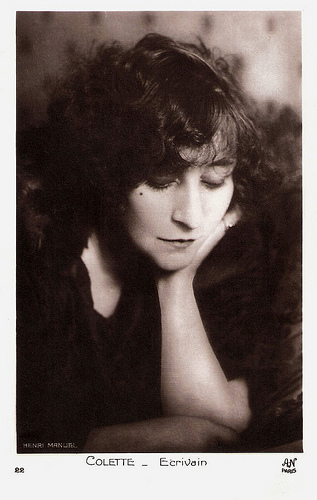
French postcard by A.N. Paris, no. 22. Photo: Henri Manuel.
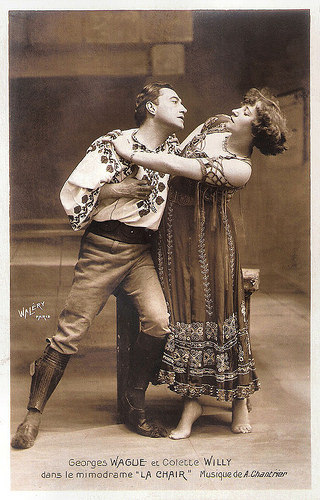
As Colette Willy with Georges Wague in La Chair (1907). French postcard. Photo: Waléry, Paris. Publicity still for the mime drama La Chair/The Flesh (1907) written by Georges Wague and Leon Lambert, with music by Albert Chantrier. It was Colette's greatest stage success.
Claudine
Sidonie-Gabrielle Colette was born in 1873, to war hero and tax collector Jules-Joseph Colette and his wife Adèle Eugénie Sidonie (Sido), nėe Landoy, in the French village of Saint-Sauveur-en-Puisaye. The family was initially well off, but by the time she was of school age poor financial management had substantially reduced her father's income and she attended a public school from the ages of 6 to 17.
In 1893, at age 20, Colette married Henry Gauthier-Villars He was a famous writer, music critic known as 'Willy'. He was 15 years her senior and described as a "literary charlatan and degenerate". He introduced Colette into avant-garde intellectual and artistic circles while engaging in sexual affairs and encouraging her own lesbian dalliances. Her first books, the titillating Claudine series, were published under her husband's pen name Willy.
The Claudine series contained the four novels Claudine à l'école/Claudine at school (1900), Claudine à Paris/Claudine in Paris (1901), Claudine en menage/Claudine Married (1902), and Claudine s'en va/Claudine and Annie (1903). They chart the coming of age of their heroine, Claudine, from an unconventional fifteen year old in a Burgundian village to the literary salons of turn-of-the-century Paris. The story they tell is semi-autobiographical, but not entirely — most strikingly, Claudine, unlike Colette, is motherless. Today, especially Claudine à l'école/Claudine at school (1900) still has the power to charm; in belle époque France it was downright shocking, much to Willy's satisfaction and profit.
Colette and Willy separated in 1906, although it was not until 1910 that the divorce became final. She had no access to the sizable earnings of the Claudine books — the copyright belonged to Willy. Colette went to work in the music halls of Paris, under the wing of Mathilde de Morny, Marquise de Belbeuf, known as 'Missy', with whom she became romantically involved. In 1907, the two performed together in Rêve d'Égypte, a pantomime at the Moulin Rouge. Their onstage kiss nearly caused a riot, which the police were called in to suppress. As a result of this scandal, further performances were banned, and Colette and de Morny were no longer able to live together openly, though their relationship continued for five years.
Until 1912 Colette followed a stage career in music halls across France, sometimes playing Claudine in sketches from her own novels, earning barely enough to survive and often hungry and unwell. This period of her life is recalled in the novel La Vagabonde/The Vagabond (1910), which deals with women's independence in a male society — a theme to which she would regularly return in future works. La Vagabonde received three votes for the prestigious Prix Goncourt.
In 1912, Colette married Henri de Jouvenel, the editor of the newspaper Le Matin. The couple had one daughter, Colette de Jouvenel. Marriage allowed her the time to writing and she devoted herself to journalism. During the war, she converted her husband's Saint-Malo estate into a hospital for the wounded. In 1920, she was made a Chevalier of the Legion of Honour.
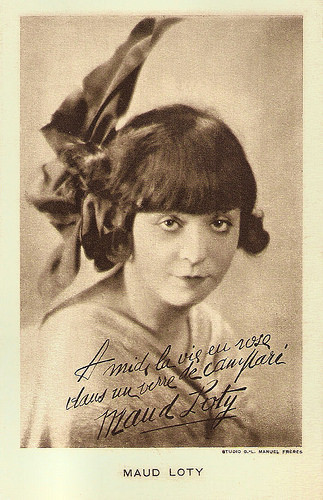
Maud Loty . French postcard. Photo: Studio G.L. Manuel Frères. Caption: "A midi la vie en rose dans un verre de Campari." Maud Loty starred in four silent Claudine films, Claudine à l'école/Claudine at school (1917), Claudine à Paris/Claudine in Paris (1917), Claudine en menage/Claudine Married (1917), and Claudine s'en va/Claudine and Annie (1917). Her co-star was Loulou Hégoburu.
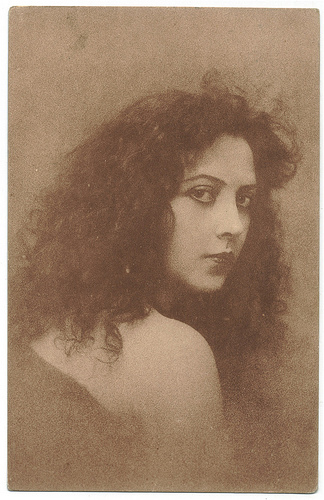
Musidora. French postcard. Photo: G.L. Manuel. Collection: Manuel Palomino Arjona. Musidora was the star of La Vagabonda/The Vagabond (Musidora, Eugenio Perego, 1918), based on Colette's novel La Vagabonde (1910).
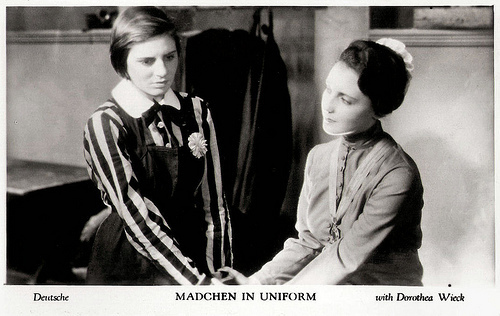
Ellen Schwannecke and Dorothea Wieck in Mädchen in Uniform (1931). British card in the series Film Shots by Film Weekly. Photo: Deutsche. Publicity still for Mädchen in Uniform/Girls in Uniform (Leontine Sagan, Carl Froelich, 1931), for which Colette wrote additional dialogues.
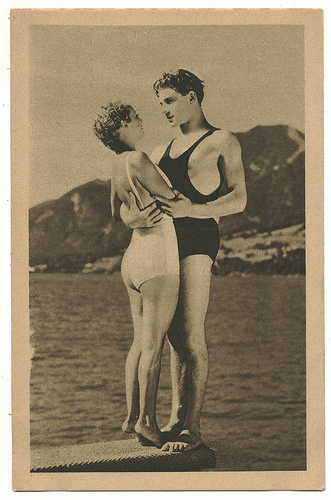
Simone Simon and Jean-Pierre Aumont in Lac aux dames (1934). French postcard. Photo: Belleville-Pathé. Publicity still for Lac aux dames/Ladies Lake (Marc Allégret, 1934), for which Colette wrote the dialogues. Collection: Manuel Palomino Arjona.
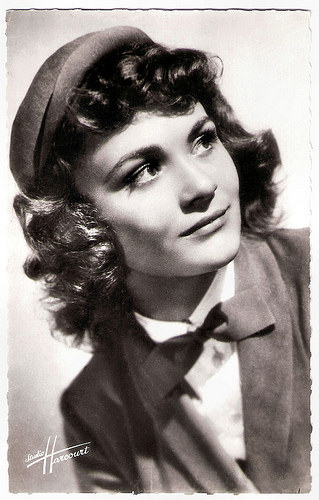
Danièle Delorme . French postcard by Editions du Globe, Paris, no. 108. Photo: Studio Harcourt. Delorme is probably best remembered for her starring roles in the original French production of Gigi (1948) and in Minne (1950), both based on novels by Colette.
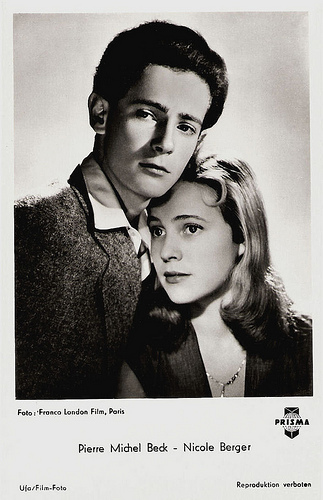
Pierre Michel Beck and Nicole Berger in Le Blé en herbe (1954). German postcard by Ufa, Berlin-Tempelhof, no. FK 1463. Photo: Franco London Film, Paris / Prisma. Publicity still for Le Blé en herbe/The Game of Love (Claude Autant-Lara, 1954).
Chéri and Gigi
Post-World War I, her writing career bloomed following the publication of Chéri (1920). Chéri tells a story of the end of a six-year affair between an ageing retired courtesan, Léa, and a pampered young man, Chéri. Léa is devastated when Chéri marries a girl his own age, and delighted when he returns to her, but after one final night together she sends him away again.
After Chéri, Colette entered the world of modern poetry and painting revolving around Jean Cocteau. She divorced Henri de Jouvenel partly due to Jouvenel's infidelities and partly to Colette's own much talked-about affair with her sixteen year old stepson, Bertrand de Jouvenel. In 1935, Colette married Maurice Goudeket, an uncle of Juliet Goudeket alias Hollywood legend Jetta Goudal . The couple stayed together until her death.
Her novel Le Blé en herbe (1923) dealed again with love between an ageing woman and a very young man, a situation reflecting her relationship with Bertrand de Jouvenel. The decades of the 1920s and 1930s were Colette's most productive and innovative period. Set mostly in Burgundy or Paris during the Belle Époque, her work treated married life, sexuality, and the problems of a woman's struggle for independence.
During the German occupation of France during World War II, her husband Maurice Goudeket, a Jew, was arrested by the Gestapo in December 1941. Although he was released after a few months through the intervention of the French wife of the German ambassador, Colette lived through the rest of the war years with the anxiety of a possible second arrest. She aided her Jewish friends, and hided her husband in her attic.
Her best known work, the novella Gigi (1944), was the basis for several films. It tells the story of sixteen year old Gilberte (Gigi) Alvar. Born into a family of demimondaines, Gigi is being trained as a courtesan to captivate a wealthy lover, but breaks with tradition by marrying him instead. In 1949 Gigi was made into a French film starring Danièle Delorme and Gaby Morlay . In 1951 Gigi was adapted for the stage ny Lerner and Loewe with the then-unknown Audrey Hepburn in the title role, picked by Colette personally. The Hollywood musical Gigi (Vinccente Minelli, 1958), starring Leslie Caron and Louis Jourdan , with a screenplay by Alan Jay Lerner and a score by Lerner and Frederick Loewe, won the Oscar for Best Picture.
In 1948, Colette was nominated for the Nobel Prize in Literature. On her death in 1954, she was refused a religious funeral by the Catholic Church on account of her divorces. Instead she was given a state funeral, the first French woman of letters to be granted this honour, and interred in Père-Lachaise cemetery. She was 81.

Leslie Caron in Gigi (1958). French postcard by Editions du Globe, Paris, no. 662. Photo: Sam Lévin. Publicity still for Gigi (Vincente Minelli, 1958).
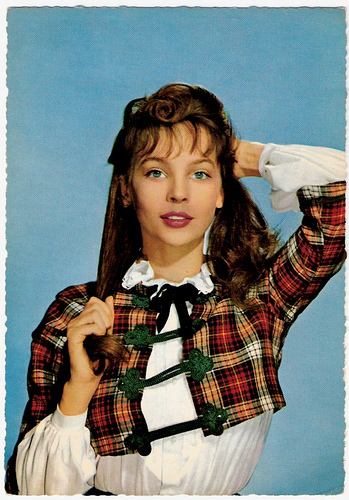
Leslie Caron in Gigi (1958). German postcard by Krüger, no. 902/34. Photo: Sam Levin. Publicity still for Gigi (Vincente Minnelli, 1958).
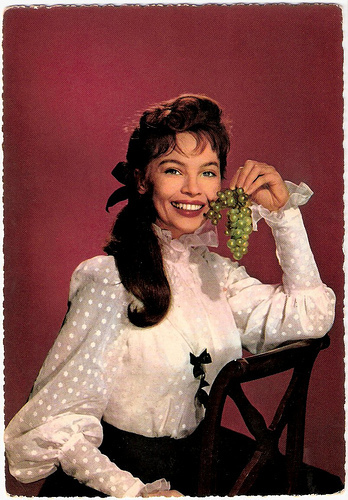
Leslie Caron in Gigi (1958). German postcard by Krüger, no. 902/35. Photo: Sam Lévin. Publicity still for Gigi (Vincente Minnelli, 1958).
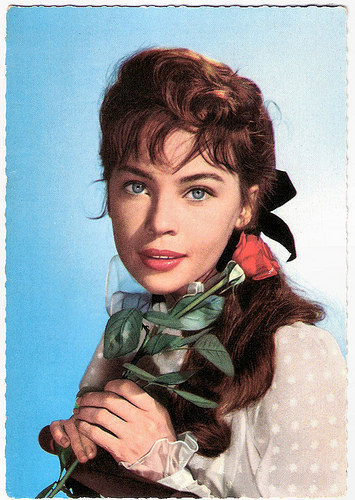
Leslie Caron in Gigi (1958). German postcard by ISV, Amsterdam, no. B 17. Photo: publicity still for Gigi (Vincente Minnelli, 1958).
Sources: Amis de Colette (French), Wikipedia and
This is a post for Postcard Friendship Friday, hosted by Beth at the The Best Hearts are Crunchy. You can visit her by clicking on the button below.


French postcard by A.N. Paris, no. 22. Photo: Henri Manuel.

As Colette Willy with Georges Wague in La Chair (1907). French postcard. Photo: Waléry, Paris. Publicity still for the mime drama La Chair/The Flesh (1907) written by Georges Wague and Leon Lambert, with music by Albert Chantrier. It was Colette's greatest stage success.
Claudine
Sidonie-Gabrielle Colette was born in 1873, to war hero and tax collector Jules-Joseph Colette and his wife Adèle Eugénie Sidonie (Sido), nėe Landoy, in the French village of Saint-Sauveur-en-Puisaye. The family was initially well off, but by the time she was of school age poor financial management had substantially reduced her father's income and she attended a public school from the ages of 6 to 17.
In 1893, at age 20, Colette married Henry Gauthier-Villars He was a famous writer, music critic known as 'Willy'. He was 15 years her senior and described as a "literary charlatan and degenerate". He introduced Colette into avant-garde intellectual and artistic circles while engaging in sexual affairs and encouraging her own lesbian dalliances. Her first books, the titillating Claudine series, were published under her husband's pen name Willy.
The Claudine series contained the four novels Claudine à l'école/Claudine at school (1900), Claudine à Paris/Claudine in Paris (1901), Claudine en menage/Claudine Married (1902), and Claudine s'en va/Claudine and Annie (1903). They chart the coming of age of their heroine, Claudine, from an unconventional fifteen year old in a Burgundian village to the literary salons of turn-of-the-century Paris. The story they tell is semi-autobiographical, but not entirely — most strikingly, Claudine, unlike Colette, is motherless. Today, especially Claudine à l'école/Claudine at school (1900) still has the power to charm; in belle époque France it was downright shocking, much to Willy's satisfaction and profit.
Colette and Willy separated in 1906, although it was not until 1910 that the divorce became final. She had no access to the sizable earnings of the Claudine books — the copyright belonged to Willy. Colette went to work in the music halls of Paris, under the wing of Mathilde de Morny, Marquise de Belbeuf, known as 'Missy', with whom she became romantically involved. In 1907, the two performed together in Rêve d'Égypte, a pantomime at the Moulin Rouge. Their onstage kiss nearly caused a riot, which the police were called in to suppress. As a result of this scandal, further performances were banned, and Colette and de Morny were no longer able to live together openly, though their relationship continued for five years.
Until 1912 Colette followed a stage career in music halls across France, sometimes playing Claudine in sketches from her own novels, earning barely enough to survive and often hungry and unwell. This period of her life is recalled in the novel La Vagabonde/The Vagabond (1910), which deals with women's independence in a male society — a theme to which she would regularly return in future works. La Vagabonde received three votes for the prestigious Prix Goncourt.
In 1912, Colette married Henri de Jouvenel, the editor of the newspaper Le Matin. The couple had one daughter, Colette de Jouvenel. Marriage allowed her the time to writing and she devoted herself to journalism. During the war, she converted her husband's Saint-Malo estate into a hospital for the wounded. In 1920, she was made a Chevalier of the Legion of Honour.

Maud Loty . French postcard. Photo: Studio G.L. Manuel Frères. Caption: "A midi la vie en rose dans un verre de Campari." Maud Loty starred in four silent Claudine films, Claudine à l'école/Claudine at school (1917), Claudine à Paris/Claudine in Paris (1917), Claudine en menage/Claudine Married (1917), and Claudine s'en va/Claudine and Annie (1917). Her co-star was Loulou Hégoburu.

Musidora. French postcard. Photo: G.L. Manuel. Collection: Manuel Palomino Arjona. Musidora was the star of La Vagabonda/The Vagabond (Musidora, Eugenio Perego, 1918), based on Colette's novel La Vagabonde (1910).

Ellen Schwannecke and Dorothea Wieck in Mädchen in Uniform (1931). British card in the series Film Shots by Film Weekly. Photo: Deutsche. Publicity still for Mädchen in Uniform/Girls in Uniform (Leontine Sagan, Carl Froelich, 1931), for which Colette wrote additional dialogues.

Simone Simon and Jean-Pierre Aumont in Lac aux dames (1934). French postcard. Photo: Belleville-Pathé. Publicity still for Lac aux dames/Ladies Lake (Marc Allégret, 1934), for which Colette wrote the dialogues. Collection: Manuel Palomino Arjona.

Danièle Delorme . French postcard by Editions du Globe, Paris, no. 108. Photo: Studio Harcourt. Delorme is probably best remembered for her starring roles in the original French production of Gigi (1948) and in Minne (1950), both based on novels by Colette.

Pierre Michel Beck and Nicole Berger in Le Blé en herbe (1954). German postcard by Ufa, Berlin-Tempelhof, no. FK 1463. Photo: Franco London Film, Paris / Prisma. Publicity still for Le Blé en herbe/The Game of Love (Claude Autant-Lara, 1954).
Chéri and Gigi
Post-World War I, her writing career bloomed following the publication of Chéri (1920). Chéri tells a story of the end of a six-year affair between an ageing retired courtesan, Léa, and a pampered young man, Chéri. Léa is devastated when Chéri marries a girl his own age, and delighted when he returns to her, but after one final night together she sends him away again.
After Chéri, Colette entered the world of modern poetry and painting revolving around Jean Cocteau. She divorced Henri de Jouvenel partly due to Jouvenel's infidelities and partly to Colette's own much talked-about affair with her sixteen year old stepson, Bertrand de Jouvenel. In 1935, Colette married Maurice Goudeket, an uncle of Juliet Goudeket alias Hollywood legend Jetta Goudal . The couple stayed together until her death.
Her novel Le Blé en herbe (1923) dealed again with love between an ageing woman and a very young man, a situation reflecting her relationship with Bertrand de Jouvenel. The decades of the 1920s and 1930s were Colette's most productive and innovative period. Set mostly in Burgundy or Paris during the Belle Époque, her work treated married life, sexuality, and the problems of a woman's struggle for independence.
During the German occupation of France during World War II, her husband Maurice Goudeket, a Jew, was arrested by the Gestapo in December 1941. Although he was released after a few months through the intervention of the French wife of the German ambassador, Colette lived through the rest of the war years with the anxiety of a possible second arrest. She aided her Jewish friends, and hided her husband in her attic.
Her best known work, the novella Gigi (1944), was the basis for several films. It tells the story of sixteen year old Gilberte (Gigi) Alvar. Born into a family of demimondaines, Gigi is being trained as a courtesan to captivate a wealthy lover, but breaks with tradition by marrying him instead. In 1949 Gigi was made into a French film starring Danièle Delorme and Gaby Morlay . In 1951 Gigi was adapted for the stage ny Lerner and Loewe with the then-unknown Audrey Hepburn in the title role, picked by Colette personally. The Hollywood musical Gigi (Vinccente Minelli, 1958), starring Leslie Caron and Louis Jourdan , with a screenplay by Alan Jay Lerner and a score by Lerner and Frederick Loewe, won the Oscar for Best Picture.
In 1948, Colette was nominated for the Nobel Prize in Literature. On her death in 1954, she was refused a religious funeral by the Catholic Church on account of her divorces. Instead she was given a state funeral, the first French woman of letters to be granted this honour, and interred in Père-Lachaise cemetery. She was 81.

Leslie Caron in Gigi (1958). French postcard by Editions du Globe, Paris, no. 662. Photo: Sam Lévin. Publicity still for Gigi (Vincente Minelli, 1958).

Leslie Caron in Gigi (1958). German postcard by Krüger, no. 902/34. Photo: Sam Levin. Publicity still for Gigi (Vincente Minnelli, 1958).

Leslie Caron in Gigi (1958). German postcard by Krüger, no. 902/35. Photo: Sam Lévin. Publicity still for Gigi (Vincente Minnelli, 1958).

Leslie Caron in Gigi (1958). German postcard by ISV, Amsterdam, no. B 17. Photo: publicity still for Gigi (Vincente Minnelli, 1958).
Sources: Amis de Colette (French), Wikipedia and
This is a post for Postcard Friendship Friday, hosted by Beth at the The Best Hearts are Crunchy. You can visit her by clicking on the button below.

Published on April 14, 2016 22:00
April 13, 2016
André van Duin
Funny-looking, reddish André van Duin (1947) is a famous comedian and actor in the Dutch-speaking countries. He is also a singer, writer, and creator of television programs, and he starred in three Dutch film comedies.

Dutch promotion card by CNR, Weesp.
The talent of amusing people
André van Duin was born in Rotterdam, The Netherlands in 1947. His birthname was Adrianus Marinus Kloot, which he legally changed to Adrianus Marinus Kyvon in 1966, a few years after taking the pseudonym André van Duin.
As a kid he developed the talent of amusing people, imitating celebrities and singing. At the age of 15 he sent letters to several TV networks, requesting an audition. In 1964 he was discovered when he won the TV talent contest show Nieuwe Oogst (New Harvest), and started appearing as a guest in a few shows, including that of singing father and daughter Willy Alberti and Willeke Alberti.
In 1965 he got the opportunity to do a television programme of his own, Een avondje TV met André/A TV evening with André. From 1967 onwards, he took apprenticeship at comedians Willy Walden and Piet Muyselaar 's Snip & Snap theatre shows.
In the 1970s André van Duin set up his own Revue with Frans van Dusschoten as the straight man and Corrie van Gorp. These shows were televised on TROS and in 1975 Van Duin won an award for Dag dag heerlijke lach/Hello hello delicious laugh (1974-1975). During this decade Van Duin recorded several hit songs such as Het bananenlied (1972), a parody of The Banana Boat Song.
In 1972, André van Duin began the radio program Dik Voormekaar Show. First with broadcasting company Radio Noordzee Internationaal, later with the NCRV and TROS. He involved his then technician, Ferry de Groot, in the show, becoming the character Meneer de Groot (Mister de Groot). The show continued to air on radio (and for a period also on TV) as recently as 2009.
André van Duin debuted as an actor in the TV series Het meisje met de blauwe hoed/The Girl With The Blue Hat (Dick van 't Sant, 1972), playing an army recruit opposite Jenny Arean. It was a TV version of the film musical Het meisje met den blauwe hoed/The Girl With The Blue Hat (Rudolf Meinert, 1934), with Truus van Aalten and Lou Bandy in the Van Duin part.
In 1976, Van Duin had a massive hit with the song Willempie. Parents of mentally challenged children considered his performance offensive. Van Duin escaped legal actions by apologising on television. Later that year, Van Duin released And're Andre (The Other Andre), an album stripped of wackiness that became the first of five volumes.
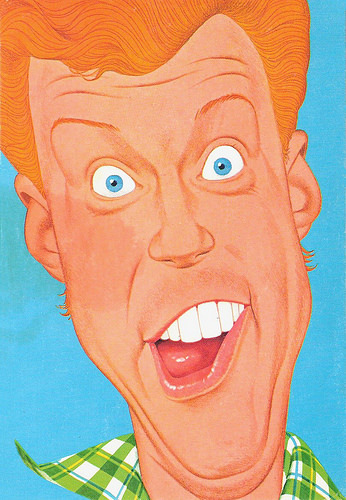
Dutch postcard by Postcheque en Girodienst, 's-Gravenhage. Illustration: n.n.
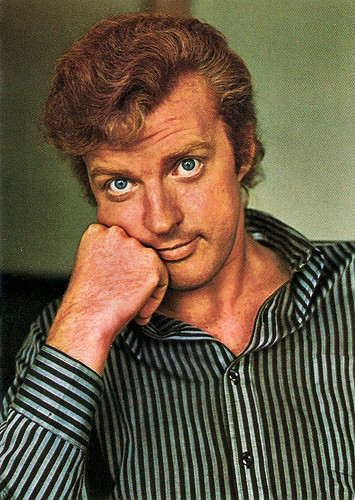
Dutch postcard by Nederlands Artisten Management, Rotterdam.
Both serious and wacky
André van Duin made his film debut with Pretfilm/Fun Film (Robert Kaesen, 1976) in which he played various characters with his croonies from his stage and TV comedies, Frans van Dusschoten and Corrie van Gorp. In 1981 he starred with the same team in another comedy, Ik Ben Joep Meloen/I am Joep Melon (Guus Verstraete, 1981), which was another reasonable success.
In 1982 followed his most ambitious film, De Boezemvriend/The Bosom Buddy (Dimitri Frenkel Frank, 1982), partly an adaptation of the Danny Kaye film The Inspector General (Henry Koster, 1949). Van Duin portrayed charlatan dentist Fred van der Zee who is mistaken for Napoleon's delegate. De Boezemvriend was considered a failure and Van Duin hasn't returned to the big screen since.
Cartoonist Toon van Driel created André's own comic book series in 1987. Very popular was the WWF-promoting TV series Animal Crackers (1988). Van Duin and his new stable-mate Ron Brandsteder were team-captains in the TV show Wie ben ik?/Who am I? (1989), hosted by Caroline Tensen.
Between 1993 and 1999 Van Duin made television shows for RTL. In 2007 the André's Nieuwe Revue-tour was launched; Belgium was visited in November 2008 for five shows in Antwerp. In 2009 he made a new series of Dik Voormekaar Shows. In 2010, Van Duin released the cd Dubbel, made up of both serious and wacky songs.
During his career, André van Duin had 41 singles in the Dutch Top 40, 22 of those reached the Top 10 of which 3 singles became number one. André van Duin was in a relationship with Wim van der Pluym from 1974 until 1995, when Van der Pluym died. Van Duin married Martin Elferink in 2006. In 2013, he returned to TV as Petrus in the hit series 't Schaep met de 5 pooten/The Sheep with five legs. On stage, he impressed with his role in The Sunshine Boys (2015).
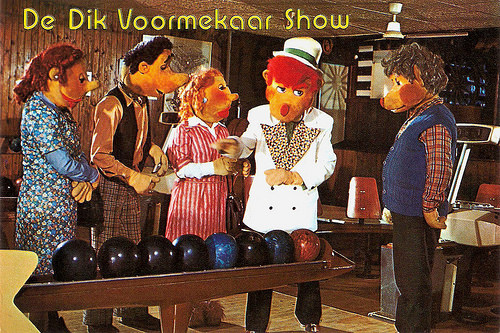
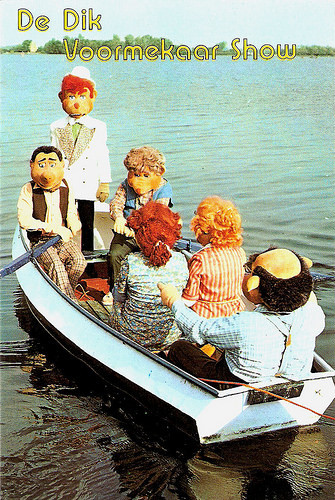
Dutch postcards by Gebr. Spanjersberg, Rotterdam / Antwerpen, 1979. Photos: NAM / Direct Promotion. Publicity stills for the TV series De Dik Voormekaar Show (Guus Verstraete, 1977-1979). TV version of the popular radio program with André van Duin and Ferry de Groot in which the various characters were portrayed on screen by hand puppets in the first season (1977-1978) and full body costumes in the second (1978-1979).
Sources: Wikipedia and .

Dutch promotion card by CNR, Weesp.
The talent of amusing people
André van Duin was born in Rotterdam, The Netherlands in 1947. His birthname was Adrianus Marinus Kloot, which he legally changed to Adrianus Marinus Kyvon in 1966, a few years after taking the pseudonym André van Duin.
As a kid he developed the talent of amusing people, imitating celebrities and singing. At the age of 15 he sent letters to several TV networks, requesting an audition. In 1964 he was discovered when he won the TV talent contest show Nieuwe Oogst (New Harvest), and started appearing as a guest in a few shows, including that of singing father and daughter Willy Alberti and Willeke Alberti.
In 1965 he got the opportunity to do a television programme of his own, Een avondje TV met André/A TV evening with André. From 1967 onwards, he took apprenticeship at comedians Willy Walden and Piet Muyselaar 's Snip & Snap theatre shows.
In the 1970s André van Duin set up his own Revue with Frans van Dusschoten as the straight man and Corrie van Gorp. These shows were televised on TROS and in 1975 Van Duin won an award for Dag dag heerlijke lach/Hello hello delicious laugh (1974-1975). During this decade Van Duin recorded several hit songs such as Het bananenlied (1972), a parody of The Banana Boat Song.
In 1972, André van Duin began the radio program Dik Voormekaar Show. First with broadcasting company Radio Noordzee Internationaal, later with the NCRV and TROS. He involved his then technician, Ferry de Groot, in the show, becoming the character Meneer de Groot (Mister de Groot). The show continued to air on radio (and for a period also on TV) as recently as 2009.
André van Duin debuted as an actor in the TV series Het meisje met de blauwe hoed/The Girl With The Blue Hat (Dick van 't Sant, 1972), playing an army recruit opposite Jenny Arean. It was a TV version of the film musical Het meisje met den blauwe hoed/The Girl With The Blue Hat (Rudolf Meinert, 1934), with Truus van Aalten and Lou Bandy in the Van Duin part.
In 1976, Van Duin had a massive hit with the song Willempie. Parents of mentally challenged children considered his performance offensive. Van Duin escaped legal actions by apologising on television. Later that year, Van Duin released And're Andre (The Other Andre), an album stripped of wackiness that became the first of five volumes.

Dutch postcard by Postcheque en Girodienst, 's-Gravenhage. Illustration: n.n.

Dutch postcard by Nederlands Artisten Management, Rotterdam.
Both serious and wacky
André van Duin made his film debut with Pretfilm/Fun Film (Robert Kaesen, 1976) in which he played various characters with his croonies from his stage and TV comedies, Frans van Dusschoten and Corrie van Gorp. In 1981 he starred with the same team in another comedy, Ik Ben Joep Meloen/I am Joep Melon (Guus Verstraete, 1981), which was another reasonable success.
In 1982 followed his most ambitious film, De Boezemvriend/The Bosom Buddy (Dimitri Frenkel Frank, 1982), partly an adaptation of the Danny Kaye film The Inspector General (Henry Koster, 1949). Van Duin portrayed charlatan dentist Fred van der Zee who is mistaken for Napoleon's delegate. De Boezemvriend was considered a failure and Van Duin hasn't returned to the big screen since.
Cartoonist Toon van Driel created André's own comic book series in 1987. Very popular was the WWF-promoting TV series Animal Crackers (1988). Van Duin and his new stable-mate Ron Brandsteder were team-captains in the TV show Wie ben ik?/Who am I? (1989), hosted by Caroline Tensen.
Between 1993 and 1999 Van Duin made television shows for RTL. In 2007 the André's Nieuwe Revue-tour was launched; Belgium was visited in November 2008 for five shows in Antwerp. In 2009 he made a new series of Dik Voormekaar Shows. In 2010, Van Duin released the cd Dubbel, made up of both serious and wacky songs.
During his career, André van Duin had 41 singles in the Dutch Top 40, 22 of those reached the Top 10 of which 3 singles became number one. André van Duin was in a relationship with Wim van der Pluym from 1974 until 1995, when Van der Pluym died. Van Duin married Martin Elferink in 2006. In 2013, he returned to TV as Petrus in the hit series 't Schaep met de 5 pooten/The Sheep with five legs. On stage, he impressed with his role in The Sunshine Boys (2015).


Dutch postcards by Gebr. Spanjersberg, Rotterdam / Antwerpen, 1979. Photos: NAM / Direct Promotion. Publicity stills for the TV series De Dik Voormekaar Show (Guus Verstraete, 1977-1979). TV version of the popular radio program with André van Duin and Ferry de Groot in which the various characters were portrayed on screen by hand puppets in the first season (1977-1978) and full body costumes in the second (1978-1979).
Sources: Wikipedia and .
Published on April 13, 2016 22:00
April 12, 2016
Der blaue Engel (1930)
Today, EFSP starts a new series of film specials. We begin with a classic of the Ufa studios, Der blaue Engel/The Blue Angel (Josef von Sternberg, 1930). It was the last of the classic films of Emil Jannings and the first of Marlene Dietrich.

Emil Jannings . German postcard by Ross Verlag, no. 4746/1, 1929-1930. Photo: Ufa. Publicity still for Der blaue Engel/The Blue Angel (1930).
Under the spell of Lola Lola
Der blaue Engel was written by Carl Zuckmayer, Karl Vollmöller and Robert Liebmann – with uncredited contributions by director Josef von Sternberg. It is based on Heinrich Mann's novel Professor Unrat (Professor Garbage).
Weimar Germany, 1924. Middle aged Dr. Immanuel Rath ( Emil Jannings ) is a respectable literature professor at the local Gymnasium – a college preparatory high school. Most of his students don't like him, and nickname him "Unrat" - German for garbage.
Dr. Rath learns that many of his boys often frequent a cabaret called Der blaue Engel - the Blue Angel - which he believes is corrupting their impressionable young minds. He heads to the Blue Angel himself to catch the boys in the act and shame them into not going again.
Rath is able to catch the boys, but in the process he also understands what attracts the boys, namely the beautiful headlining performer Lola Lola ( Marlene Dietrich ). Consumed with desire for Lola, Rath returns to the cabaret the following evening, to return a pair of panties that were smuggled into his coat by one of his students, and stays the night with her.
Lola seemingly also falls in love with him. Rath subsequently resigns from his position at the academy to marry Lola and travels with her from cabaret to cabaret. He becomes a clown in Lola's cabaret troupe to pay the bills.
Their relationship ends up not being what either envisioned. His growing insecurities about Lola's profession as a "shared woman" eventually consume him with lust and jealousy. As Rath performs his last act, he witnesses his wife embrace and kiss the strongman Mazeppa ( Hans Albers ), her new love interest, and is enraged to the point of insanity. He attempts to strangle Lola, but is beaten down by the other members of the troupe and locked in a straitjacket.

Small German collectors card. Photo: Super film. Publicity still for Der blaue Engel/The Blue Angel (Josef von Sternberg, 1930) with Marlene Dietrich .

Small German collectors card. Photo: Super film. Publicity still for Der blaue Engel/The Blue Angel (Josef von Sternberg, 1930) with Emil Jannings and Marlene Dietrich .

Small German collectors card. Photo: Super film. Publicity still for Der blaue Engel/The Blue Angel (Josef von Sternberg, 1930) with Kurt Gerron and Marlene Dietrich .

Small German collectors card. Photo: Super film. Publicity still for Der blaue Engel/The Blue Angel (Josef von Sternberg, 1930) with Emil Jannings .

German collectors card. Photo: Super film. Publicity still for Der blaue Engel/The Blue Angel (Josef von Sternberg, 1930) with Hans Albers and Marlene Dietrich .

German collectors card. Photo: Super film. Publicity still for Der blaue Engel/The Blue Angel (Josef von Sternberg, 1930) with Emil Jannings and Marlene Dietrich .
Dietrich's bored, world-weary attitude
Der blaue Engel/The Blue Angel (1930) was Emil Jannings 's first film back in Germany after his trip to Hollywood, where he had won two Oscars with silent films. It was also his final English-language film. Der blaue Engel was released in both German and English versions, although the latter version was thought lost for many years. The German version is considered to be superior, it is longer and not marred by actors struggling with their English pronunciation.
Many actresses from the stage and screen were considered for the role of Lola Lola. Among the early contenders were Gloria Swanson , Louise Brooks , Brigitte Helm , Lya De Putti , Käthe Haack and Lotte Lenya.
There are various accounts of why Marlene Dietrich was cast as Lola Lola, but the one given by director Josef von Sternberg in his autobiography is that Dietrich came to test for the film with a bored, world-weary attitude because she was convinced she wasn't going to get the role and was merely going through the motions - and Sternberg hired her because that world-weary attitude was precisely what he wanted for the character.
Dietrich's screen test for has survived. In it, she pretends to upbraid her pianist, Friedrich Hollaender, the film's composer. She then sings the chorus of You're the Cream In My Coffee, after which she climbs on the piano, hitches up her skirt to show her legs and sings, in German, a torch song called Why Cry by Peter Kreuder, a well-known song-writer who became the film's orchestrator. As the test ends, Dietrich breaks character and apologizes to Hollander.
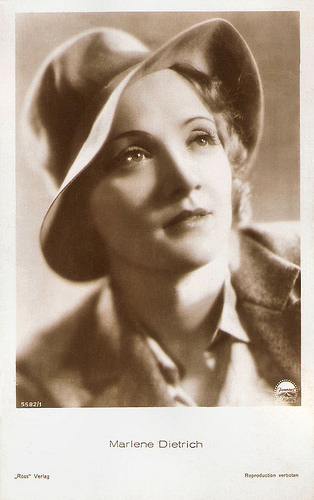
Marlene Dietrich . German postcard by Ross Verlag, no. 5582/1, 1930-1931. Photo: Paramount.
Original trailer for Der blaue Engel (1930). Source: Eurekaentertainment (YouTube).
Sources: Wikipedia and IMDb.

Emil Jannings . German postcard by Ross Verlag, no. 4746/1, 1929-1930. Photo: Ufa. Publicity still for Der blaue Engel/The Blue Angel (1930).
Under the spell of Lola Lola
Der blaue Engel was written by Carl Zuckmayer, Karl Vollmöller and Robert Liebmann – with uncredited contributions by director Josef von Sternberg. It is based on Heinrich Mann's novel Professor Unrat (Professor Garbage).
Weimar Germany, 1924. Middle aged Dr. Immanuel Rath ( Emil Jannings ) is a respectable literature professor at the local Gymnasium – a college preparatory high school. Most of his students don't like him, and nickname him "Unrat" - German for garbage.
Dr. Rath learns that many of his boys often frequent a cabaret called Der blaue Engel - the Blue Angel - which he believes is corrupting their impressionable young minds. He heads to the Blue Angel himself to catch the boys in the act and shame them into not going again.
Rath is able to catch the boys, but in the process he also understands what attracts the boys, namely the beautiful headlining performer Lola Lola ( Marlene Dietrich ). Consumed with desire for Lola, Rath returns to the cabaret the following evening, to return a pair of panties that were smuggled into his coat by one of his students, and stays the night with her.
Lola seemingly also falls in love with him. Rath subsequently resigns from his position at the academy to marry Lola and travels with her from cabaret to cabaret. He becomes a clown in Lola's cabaret troupe to pay the bills.
Their relationship ends up not being what either envisioned. His growing insecurities about Lola's profession as a "shared woman" eventually consume him with lust and jealousy. As Rath performs his last act, he witnesses his wife embrace and kiss the strongman Mazeppa ( Hans Albers ), her new love interest, and is enraged to the point of insanity. He attempts to strangle Lola, but is beaten down by the other members of the troupe and locked in a straitjacket.

Small German collectors card. Photo: Super film. Publicity still for Der blaue Engel/The Blue Angel (Josef von Sternberg, 1930) with Marlene Dietrich .

Small German collectors card. Photo: Super film. Publicity still for Der blaue Engel/The Blue Angel (Josef von Sternberg, 1930) with Emil Jannings and Marlene Dietrich .

Small German collectors card. Photo: Super film. Publicity still for Der blaue Engel/The Blue Angel (Josef von Sternberg, 1930) with Kurt Gerron and Marlene Dietrich .

Small German collectors card. Photo: Super film. Publicity still for Der blaue Engel/The Blue Angel (Josef von Sternberg, 1930) with Emil Jannings .

German collectors card. Photo: Super film. Publicity still for Der blaue Engel/The Blue Angel (Josef von Sternberg, 1930) with Hans Albers and Marlene Dietrich .

German collectors card. Photo: Super film. Publicity still for Der blaue Engel/The Blue Angel (Josef von Sternberg, 1930) with Emil Jannings and Marlene Dietrich .
Dietrich's bored, world-weary attitude
Der blaue Engel/The Blue Angel (1930) was Emil Jannings 's first film back in Germany after his trip to Hollywood, where he had won two Oscars with silent films. It was also his final English-language film. Der blaue Engel was released in both German and English versions, although the latter version was thought lost for many years. The German version is considered to be superior, it is longer and not marred by actors struggling with their English pronunciation.
Many actresses from the stage and screen were considered for the role of Lola Lola. Among the early contenders were Gloria Swanson , Louise Brooks , Brigitte Helm , Lya De Putti , Käthe Haack and Lotte Lenya.
There are various accounts of why Marlene Dietrich was cast as Lola Lola, but the one given by director Josef von Sternberg in his autobiography is that Dietrich came to test for the film with a bored, world-weary attitude because she was convinced she wasn't going to get the role and was merely going through the motions - and Sternberg hired her because that world-weary attitude was precisely what he wanted for the character.
Dietrich's screen test for has survived. In it, she pretends to upbraid her pianist, Friedrich Hollaender, the film's composer. She then sings the chorus of You're the Cream In My Coffee, after which she climbs on the piano, hitches up her skirt to show her legs and sings, in German, a torch song called Why Cry by Peter Kreuder, a well-known song-writer who became the film's orchestrator. As the test ends, Dietrich breaks character and apologizes to Hollander.

Marlene Dietrich . German postcard by Ross Verlag, no. 5582/1, 1930-1931. Photo: Paramount.
Original trailer for Der blaue Engel (1930). Source: Eurekaentertainment (YouTube).
Sources: Wikipedia and IMDb.
Published on April 12, 2016 22:00
April 11, 2016
Tom Jones
Welsh singer Tom Jones (1940) is particularly noted for his powerful voice. Since the mid 1960s, this ‘vocal powerhouse’ has sold over 100 million records. Many of his songs can be heard on film soundtracks, and he also regularly appeared as a singer and an actor in films and TV-series. In his time Tom Jones has tried his hand at styles including pop, rock, R&B, country, big band, dance, techno, gospel and jazz, and he's still going strong today. Despite his many well publicised infidelities, womaniser Jones was married to the same woman since 1957. Last Sunday, his wife Linda has died from cancer.

Italian postcard by Silvercart, Milano (Milan), no. 532/8.

French postcard by ps, no. 1399.
Too Raucous and Raunchy
Tom Jones was born Thomas John Woodward in Pontypridd, South Wales, in 1940. His parents were Freda Jones and Thomas Woodward, a coal miner.
Jones began singing at an early age: he'd regularly perform at family gatherings, weddings and his mother's Women's Guild meetings. At 16, he left school. He married his high school girlfriend, Linda Trenchard the following year, one month before their son Mark was born. To support his young family, Jones took a job working in a glove factory and was later employed in construction.
At night, he sang in pubs. Jones' bluesy singing style developed out of the sound of American soul music. His early influences included blues and R & B greats like Little Richard, Solomon Burke, and Jackie Wilson. Jones became the front man for Tommy Scott and the Senators, a Welsh beat group, in 1963. They soon gained a local following and reputation in South Wales.
Gordon Mills, a performer who had branched out into songwriting and management went to see him. He became his manager and contrived the stage name, Tom Jones, which not only linked the singer to the image of the title character in Tony Richardson's hit film Tom Jones (1963) starring Albert Finney , but also emphasised Jones' Welsh nationality. Many record companies found Jones' stage presence, act, and vocal delivery too raucous and raunchy. Eventually, Mills got Jones a recording contract with Decca.
His first single, Chills and Fever, was released in late 1964. It didn't chart, but the follow-up, It's Not Unusual became an international hit. The BBC initially refused to play it, but the offshore pirate radio station Radio Caroline promoted it. The heavily orchestrated pop arrangement perfectly meshed with Jones' swinging, sexy image, and in early 1965, It's Not Unusual reached number one in the United Kingdom and the top ten in the United States.

Dutch postcard by 't Sticht, Utrecht, no. AX 7048.

Dutch postcard, no. 968.

Dutch postcard by Muziek Parade, no. AX 6249.
A More Respectable and Mature Crooner
During 1965, Gordon Mills secured a number of film themes for Tom Jones to record, including the themes for the comedy What's New Pussycat? (Clive Donner, Richard Talmadge, 1965), written by Burt Bacharach and Hal David, and for the James Bond film Thunderball (Terence Young, 1965) starring Sean Connery .
Jones was also awarded the Grammy Award for Best New Artist for 1965. In 1966, Jones' popularity began to slip somewhat, causing Mills to redesign the singer's image into a more respectable and mature crooner. Jones also began to sing material that appealed to a wider audience, such as the big country hit Green, Green Grass of Home. The strategy worked and Jones returned to the top of the charts in the UK and began hitting the Top 40 again in the USA.
For the remainder of the decade, he scored a consistent string of hits on both sides of the Atlantic. In 1967, Jones performed for the first time in Las Vegas at the Flamingo. His charismatic performances and style of dress (increasingly featuring his open half unbuttoned shirts and tight pants) became part of his stage act. Women would swoon and scream, and some would throw their knickers on stage.
Soon after he began to play Las Vegas, he chose to record less, instead concentrating on his lucrative club performances. However, one of Tom's best-loved singles was released in 1968. Delilah was a dark tale of murder and infidelity, but people were entranced by the melody and Jones' unforgettable delivery. It became a big hit.
Jones had an internationally successful television variety show from 1969 to 1971, titled This Is Tom Jones. The show, which was worth a reported $9m to Jones over three years, was broadcast by ITV in the UK and by ABC in America. From 1980 to 1981, he had a second television variety show, The Tom Jones Show, which lasted for a series of 24 episodes.

Italian postcard. Photo: Decca.

German postcard by Kolibri-Verlag, no. 31262. Photo: Decca / Teldec.

French postcard by PSG, no. 1453.
Kiss
In the early 1970s, Tom Jones had a number of hit singles, including She's A Lady, Till, and The Young New Mexican Puppeteer, but in the mid 1970s his popularity declined, although he did have a big hit in 1976 with Say You'll Stay Until Tomorrow, which went to #1 on the US country chart and #15 on the Billboard Hot 100.
He appeared in such TV films as Showdown at O.K. Corral (Nicholas Webster, 1972) and Pleasure Cove (Bruce Bilson, 1979). In 1974, Tom finally moved to America, buying the mansion formerly belonging to Dean Martin in Los Angeles' Bel Air. In the early 1980s, Jones started to record country music. From 1980 to 1986, Jones had nine songs hit the top 40 on the US country chart, yet he failed to crack the top 100 in the UK or chart on the Billboard Hot 100.
After Jones' long-time manager Gordon Mills died of cancer in 1986, Jones' son Mark became his new manager. Mark recognised that Jones was incorporating modern music in his live shows and suggested that he should start to record songs from a fresh genre and leave country music behind. In 1987, Jones re-entered the singles chart with A Boy From Nowhere, which went to #2 in The UK. The following year, he covered Prince's Kiss with The Art of Noise. The song was a hit on both sides of the Atlantic, reaching #5 in the UK and #31 in the US. The video for Kiss won the MTV Video Music Award for Breakthrough Video.
Jones received a star on the Hollywood Walk of Fame in 1989. He played a leading part in the British TV film The Ghosts of Oxford Street (Malcolm McLaren, 1991). In 1993, he appeared as himself on the sitcom The Fresh Prince of Bel-Air and in animated form for an episode of The Simpsons.
Jones signed with Interscope Records in 1993 and released the album The Lead And How To Swing It. He played a photographer in the romantic comedy Silk n' Sabotage (Joe Cauley, 1994), did a cameo in the comedy The Jerky Boys (James Melkonian, 1995), and was himself between the Martians in the hilarious Mars Attacks (Tim Burton, 1996).
In 1999, Jones released the album Reload, a collection of cover duets with artists such as The Cardigans, Van Morrison, Portishead, The Stereophonics, and Robbie Williams. The album went to #1 in the UK and sold over 4 million copies worldwide. The next year he lent his voice to Walt Disney’s animation film The Emperor's New Groove (Mark Dindal, 2000).
In 2002, Jones released the album Mr. Jones, which was produced by Wyclef Jean. The album and the first single, Tom Jones International, were top 40 hits in the UK. Jones received the Brit Award for Outstanding Contribution to Music in 2003. The following year, he teamed up with pianist Jools Holland and released Tom Jones & Jools Holland, a roots rock 'n' roll album. It peaked at #5 in the UK.
In 2005, the BBC reported that Jones was Wales' wealthiest entertainer, having amassed a fortune of £175 million. Jones, who was awarded an OBE in 1999, was knighted by Queen Elizabeth II in 2006 at Buckingham Palace for his services to music. In 2010, his latest album Praise & Blame debuted at number 2 on the UK album chart.
In October 2015 Tom Jones' autobiography entitled Over the Top and Back: The Autobiography was published by Michael Joseph. A new musical, Tom Jones the Musical, based on the singer's life and recordings, opened at the Wales Millennium Centre in March 2016. Tom Jones has remained married to his wife Melinda Rose Woodward, known as Linda since 1957, despite his many well publicised infidelities. Linda passed away on 9 April 2016. The couple lived in Los Angeles and London. Their two grandchildren are Alexander born (1983) and Emma (1987). I
Tom Jones sings Chills and Fever in The Beat Room (1964). Source: projecth112 (YouTube).
Tom Jones sings Delilah. Source: Videos Destacados (YouTube).
Clip of Tom Jones singing Sex Bomb. Source: Music Entertainment (YouTube).
Clip of The Cardigans ft. Tom Jones singing Burning Down The House. Source: DEK DOGBOLTER (YouTube). (reversed video)
Sources: BBC, Wikipedia and .

Italian postcard by Silvercart, Milano (Milan), no. 532/8.

French postcard by ps, no. 1399.
Too Raucous and Raunchy
Tom Jones was born Thomas John Woodward in Pontypridd, South Wales, in 1940. His parents were Freda Jones and Thomas Woodward, a coal miner.
Jones began singing at an early age: he'd regularly perform at family gatherings, weddings and his mother's Women's Guild meetings. At 16, he left school. He married his high school girlfriend, Linda Trenchard the following year, one month before their son Mark was born. To support his young family, Jones took a job working in a glove factory and was later employed in construction.
At night, he sang in pubs. Jones' bluesy singing style developed out of the sound of American soul music. His early influences included blues and R & B greats like Little Richard, Solomon Burke, and Jackie Wilson. Jones became the front man for Tommy Scott and the Senators, a Welsh beat group, in 1963. They soon gained a local following and reputation in South Wales.
Gordon Mills, a performer who had branched out into songwriting and management went to see him. He became his manager and contrived the stage name, Tom Jones, which not only linked the singer to the image of the title character in Tony Richardson's hit film Tom Jones (1963) starring Albert Finney , but also emphasised Jones' Welsh nationality. Many record companies found Jones' stage presence, act, and vocal delivery too raucous and raunchy. Eventually, Mills got Jones a recording contract with Decca.
His first single, Chills and Fever, was released in late 1964. It didn't chart, but the follow-up, It's Not Unusual became an international hit. The BBC initially refused to play it, but the offshore pirate radio station Radio Caroline promoted it. The heavily orchestrated pop arrangement perfectly meshed with Jones' swinging, sexy image, and in early 1965, It's Not Unusual reached number one in the United Kingdom and the top ten in the United States.

Dutch postcard by 't Sticht, Utrecht, no. AX 7048.

Dutch postcard, no. 968.

Dutch postcard by Muziek Parade, no. AX 6249.
A More Respectable and Mature Crooner
During 1965, Gordon Mills secured a number of film themes for Tom Jones to record, including the themes for the comedy What's New Pussycat? (Clive Donner, Richard Talmadge, 1965), written by Burt Bacharach and Hal David, and for the James Bond film Thunderball (Terence Young, 1965) starring Sean Connery .
Jones was also awarded the Grammy Award for Best New Artist for 1965. In 1966, Jones' popularity began to slip somewhat, causing Mills to redesign the singer's image into a more respectable and mature crooner. Jones also began to sing material that appealed to a wider audience, such as the big country hit Green, Green Grass of Home. The strategy worked and Jones returned to the top of the charts in the UK and began hitting the Top 40 again in the USA.
For the remainder of the decade, he scored a consistent string of hits on both sides of the Atlantic. In 1967, Jones performed for the first time in Las Vegas at the Flamingo. His charismatic performances and style of dress (increasingly featuring his open half unbuttoned shirts and tight pants) became part of his stage act. Women would swoon and scream, and some would throw their knickers on stage.
Soon after he began to play Las Vegas, he chose to record less, instead concentrating on his lucrative club performances. However, one of Tom's best-loved singles was released in 1968. Delilah was a dark tale of murder and infidelity, but people were entranced by the melody and Jones' unforgettable delivery. It became a big hit.
Jones had an internationally successful television variety show from 1969 to 1971, titled This Is Tom Jones. The show, which was worth a reported $9m to Jones over three years, was broadcast by ITV in the UK and by ABC in America. From 1980 to 1981, he had a second television variety show, The Tom Jones Show, which lasted for a series of 24 episodes.

Italian postcard. Photo: Decca.

German postcard by Kolibri-Verlag, no. 31262. Photo: Decca / Teldec.

French postcard by PSG, no. 1453.
Kiss
In the early 1970s, Tom Jones had a number of hit singles, including She's A Lady, Till, and The Young New Mexican Puppeteer, but in the mid 1970s his popularity declined, although he did have a big hit in 1976 with Say You'll Stay Until Tomorrow, which went to #1 on the US country chart and #15 on the Billboard Hot 100.
He appeared in such TV films as Showdown at O.K. Corral (Nicholas Webster, 1972) and Pleasure Cove (Bruce Bilson, 1979). In 1974, Tom finally moved to America, buying the mansion formerly belonging to Dean Martin in Los Angeles' Bel Air. In the early 1980s, Jones started to record country music. From 1980 to 1986, Jones had nine songs hit the top 40 on the US country chart, yet he failed to crack the top 100 in the UK or chart on the Billboard Hot 100.
After Jones' long-time manager Gordon Mills died of cancer in 1986, Jones' son Mark became his new manager. Mark recognised that Jones was incorporating modern music in his live shows and suggested that he should start to record songs from a fresh genre and leave country music behind. In 1987, Jones re-entered the singles chart with A Boy From Nowhere, which went to #2 in The UK. The following year, he covered Prince's Kiss with The Art of Noise. The song was a hit on both sides of the Atlantic, reaching #5 in the UK and #31 in the US. The video for Kiss won the MTV Video Music Award for Breakthrough Video.
Jones received a star on the Hollywood Walk of Fame in 1989. He played a leading part in the British TV film The Ghosts of Oxford Street (Malcolm McLaren, 1991). In 1993, he appeared as himself on the sitcom The Fresh Prince of Bel-Air and in animated form for an episode of The Simpsons.
Jones signed with Interscope Records in 1993 and released the album The Lead And How To Swing It. He played a photographer in the romantic comedy Silk n' Sabotage (Joe Cauley, 1994), did a cameo in the comedy The Jerky Boys (James Melkonian, 1995), and was himself between the Martians in the hilarious Mars Attacks (Tim Burton, 1996).
In 1999, Jones released the album Reload, a collection of cover duets with artists such as The Cardigans, Van Morrison, Portishead, The Stereophonics, and Robbie Williams. The album went to #1 in the UK and sold over 4 million copies worldwide. The next year he lent his voice to Walt Disney’s animation film The Emperor's New Groove (Mark Dindal, 2000).
In 2002, Jones released the album Mr. Jones, which was produced by Wyclef Jean. The album and the first single, Tom Jones International, were top 40 hits in the UK. Jones received the Brit Award for Outstanding Contribution to Music in 2003. The following year, he teamed up with pianist Jools Holland and released Tom Jones & Jools Holland, a roots rock 'n' roll album. It peaked at #5 in the UK.
In 2005, the BBC reported that Jones was Wales' wealthiest entertainer, having amassed a fortune of £175 million. Jones, who was awarded an OBE in 1999, was knighted by Queen Elizabeth II in 2006 at Buckingham Palace for his services to music. In 2010, his latest album Praise & Blame debuted at number 2 on the UK album chart.
In October 2015 Tom Jones' autobiography entitled Over the Top and Back: The Autobiography was published by Michael Joseph. A new musical, Tom Jones the Musical, based on the singer's life and recordings, opened at the Wales Millennium Centre in March 2016. Tom Jones has remained married to his wife Melinda Rose Woodward, known as Linda since 1957, despite his many well publicised infidelities. Linda passed away on 9 April 2016. The couple lived in Los Angeles and London. Their two grandchildren are Alexander born (1983) and Emma (1987). I
Tom Jones sings Chills and Fever in The Beat Room (1964). Source: projecth112 (YouTube).
Tom Jones sings Delilah. Source: Videos Destacados (YouTube).
Clip of Tom Jones singing Sex Bomb. Source: Music Entertainment (YouTube).
Clip of The Cardigans ft. Tom Jones singing Burning Down The House. Source: DEK DOGBOLTER (YouTube). (reversed video)
Sources: BBC, Wikipedia and .
Published on April 11, 2016 22:00
April 10, 2016
Emma Gramatica
Emma Gramatica (1874-1965) was a ‘monstre sacré’ of the Italian stage, but she also played many old ladies in Italian films of the 1930s to the 1950s.

Italian postcard, no. 664. Photo: Sciutto, Genoa.

German postcard by NPG (Neue Photographische Gesellschaft), no. 6. Card dated 11 September 1903. Back is Italian: ASC Diffida.
Far from flashy
Emma Gramatica, originally Aida Laura Argia Gramatica, was born in 1974 in Borgo San Donnino, Italy (now Fidenza). She was the sister of the equally famous Irma Gramatica and the less known Anna Adele Alberta Gramatica a.k.a. Anna Capodaglio.
She made her stage debut as a teenager next to Eleonora Duse in La Gioconda by Gabriele D'Annunzio. Emma's physical appearance was far from flashy, but she showed an elegantly incisive interpretive charge.
Emma was the first actress at the stage companies of some of the most prestigious names in the Italian theatre of the late 19th and the early 20th century, such as Ermete Zacconi , Flavio Andò, Enrico Reinach and Ermete Novelli.
In the 1910s she formed the famous company Gramatica-Carini-Piperno, in which many great actors had their formation such as Renzo Ricci and Lola Braccini.
In 1916 she debuted on the silver screen as a marriage wrecker in Quando il canto si spegne/When the hand goes out (Emilio Graziani-Walter, 1916), opposite Luigi Serventi and produced by the Milanese company General Film. Even if praising her stage qualities, the press condemned her for her looks and theatricality, and didn’t accept her as the mistress for which a man breaks up his marriage. Gramatica got the message and stayed away from the screen until the arrival of sound cinema in Italy.

Italian postcard by Ed. Stab. Capecchi, Livorno, no. 118. Photo: Capecchi, Livorno.

Italian postcard by Leonar, no. 2131. August 1922.

Italian postcard, no. 655. Photo: Sciutto, Genoa.
Acute and pathetic tones
From the early 1930s, Emma Gramatica did prose on radio, first with EIAR and later also with RAI. Gramatica was an actress of the old naturalist school, of acute and pathetic tones.
At a high age she started a successful film and television career, probably debuting in La vecchia signora/The Old Lady (Amleto Palermi, 1931) as an impoverished lady who sells chestnuts on the streets to support her niece.
Gramatica was memorable in Napoli d’altri tempi/Naples of Former Days (Amleto Palermi, 1938) starring Vittorio De Sica , in Mamma/Mother (Guido Brignone, 1941) as the mother of Beniamino Gigli , and in Sissignora/Yes, Madam (Ferdinando Maria Poggioli, 1941).
In Sorelle Materassi/The Materassi Sisters (Ferdinando Maria Poggioli, 1944), she and her sister Irma played two old spinsters, and in Miracolo in Milano/Miracle in Milan (Vittorio De Sica, 1951) she played old Lolotta who finds baby Totò (Francesco Golisano) among the cauliflowers in her garden and raises him with an optimist and kind outlook. She also appeared in Don Camillo Monsignore ... ma non troppo/Don Camillo: Monsignor (Carmine Gallone, 1961).
Emma Gramatica received awards and honors in Italy and also the Legion of Honor in France. She died in 1965 in Ostia, near Rome, and rests in the family tomb in the cemetery of Signa, with her sister Irma and their parents.

Italian postcard by Ed. A. Vettori, Bologna. Photo: Badodi, Milano.

Italian/German postcard by NPG, no. 7. Back: ASC Diffida.
Sources: Wikipedia (Italian and English) and .

Italian postcard, no. 664. Photo: Sciutto, Genoa.

German postcard by NPG (Neue Photographische Gesellschaft), no. 6. Card dated 11 September 1903. Back is Italian: ASC Diffida.
Far from flashy
Emma Gramatica, originally Aida Laura Argia Gramatica, was born in 1974 in Borgo San Donnino, Italy (now Fidenza). She was the sister of the equally famous Irma Gramatica and the less known Anna Adele Alberta Gramatica a.k.a. Anna Capodaglio.
She made her stage debut as a teenager next to Eleonora Duse in La Gioconda by Gabriele D'Annunzio. Emma's physical appearance was far from flashy, but she showed an elegantly incisive interpretive charge.
Emma was the first actress at the stage companies of some of the most prestigious names in the Italian theatre of the late 19th and the early 20th century, such as Ermete Zacconi , Flavio Andò, Enrico Reinach and Ermete Novelli.
In the 1910s she formed the famous company Gramatica-Carini-Piperno, in which many great actors had their formation such as Renzo Ricci and Lola Braccini.
In 1916 she debuted on the silver screen as a marriage wrecker in Quando il canto si spegne/When the hand goes out (Emilio Graziani-Walter, 1916), opposite Luigi Serventi and produced by the Milanese company General Film. Even if praising her stage qualities, the press condemned her for her looks and theatricality, and didn’t accept her as the mistress for which a man breaks up his marriage. Gramatica got the message and stayed away from the screen until the arrival of sound cinema in Italy.

Italian postcard by Ed. Stab. Capecchi, Livorno, no. 118. Photo: Capecchi, Livorno.

Italian postcard by Leonar, no. 2131. August 1922.

Italian postcard, no. 655. Photo: Sciutto, Genoa.
Acute and pathetic tones
From the early 1930s, Emma Gramatica did prose on radio, first with EIAR and later also with RAI. Gramatica was an actress of the old naturalist school, of acute and pathetic tones.
At a high age she started a successful film and television career, probably debuting in La vecchia signora/The Old Lady (Amleto Palermi, 1931) as an impoverished lady who sells chestnuts on the streets to support her niece.
Gramatica was memorable in Napoli d’altri tempi/Naples of Former Days (Amleto Palermi, 1938) starring Vittorio De Sica , in Mamma/Mother (Guido Brignone, 1941) as the mother of Beniamino Gigli , and in Sissignora/Yes, Madam (Ferdinando Maria Poggioli, 1941).
In Sorelle Materassi/The Materassi Sisters (Ferdinando Maria Poggioli, 1944), she and her sister Irma played two old spinsters, and in Miracolo in Milano/Miracle in Milan (Vittorio De Sica, 1951) she played old Lolotta who finds baby Totò (Francesco Golisano) among the cauliflowers in her garden and raises him with an optimist and kind outlook. She also appeared in Don Camillo Monsignore ... ma non troppo/Don Camillo: Monsignor (Carmine Gallone, 1961).
Emma Gramatica received awards and honors in Italy and also the Legion of Honor in France. She died in 1965 in Ostia, near Rome, and rests in the family tomb in the cemetery of Signa, with her sister Irma and their parents.

Italian postcard by Ed. A. Vettori, Bologna. Photo: Badodi, Milano.

Italian/German postcard by NPG, no. 7. Back: ASC Diffida.
Sources: Wikipedia (Italian and English) and .
Published on April 10, 2016 22:00
April 9, 2016
Yevgeni Urbansky
The creative life of prominent Soviet actor Yevgeni Urbansky (1932-1965) was short but very bright. In 1958 he rushed into the Russian cinema bursting with an irrepressible temperament and a craving for life. With his tragic death at the age of 33, a whole cinema epoch with peculiar aesthetics disappeared with him.

Russian postcard by Izdanije Byuro Propogandy Sovietskogo Kinoiskusstva, no. 00034, 1962. This postcard was printed in an edition of 125.000 cards. The price was 8 kop.

Romanian collectors card.
The Communist
Yevgeni Yakovlevich Urbansky (Russian: Евгений Яковлевич Урбанский) or Evgeniy Urbanskiy was born in 1932 in Moscow, into the family of a Communist party worker. In 1957 he finished the Drama School Studio attached to MXAT and was admitted to the company of the Stanislavsky Moscow Drama Theatre.
His starring debut in the film Kommunist/The Communist (Yuli Raizman, 1958) brought him the adoration of the public, film critics and authorities as well. At AllMovie, Hal Erickson writes: "Yevgeny Urbansky plays Vassili, a dedicated communist who assumes control of a strategically important warehouse during the 1917 revolution. Almost single-handedly, Vassili fends off the counterattacks of the loyalist White Russians, here depicted as double-dyed villains. He finds time to romance the beautiful Aniuta (Sofya Pavlova) before he meets a spectacular death at the hands of 20 of his enemies. Even those unsympathetic to the film's politics will be swept up by the excitement and grandeur of Rasskaz Moei Materi (Stories of My Mother - the alternative title of Kommunist)."
The film won awards at the festivals in Venice and Kiev in 1958. In 1959 Kommunist was named among the three best films of the year according to the readers of the magazine Sovetsky Ekran (Soviet Screen). Urbansky next took his time to enrich his acting experience on stage, playing in around 22 to 25 plays every month.
Only in the middle of 1958 he finally turned to the cinema again. In the war drama Ballada o soldate/Ballad of a Soldier (Grigori Chukhrai, 1959), he played a nameless disabled soldier whom the main character Alesha Skvortsov comes across at a railway station.
At Senses of Cinema, Julia Levin writes: "A guy he meets at a train station, Vasya, lost his leg in the war and is contemplating not returning to his wife. An invalid, he is fearful of her disdain. Yevgeni Urbansky, a wonderful actor whose cinematic fame was as sudden as it was short-lived, plays the role. (...) Persuaded by Alexei, Vasya returns to his hometown. The suspense becomes almost unbearable while the two of them wait for Vasya’s wife (Elza Lezhdey) at a train station. It looks like she will never come – yet she does, and the two reunite nervously in a sweet embrace, walking down the platform without being able to hold each other’s hands. Moments like this fill the screen with an indelible power – a simple and poetic legacy that has given Ballad of a Soldier its historic longevity."

Russian postcard by Izdanije Byuro Propogandy Sovietskogo Kinoiskusstva, no. A 11456, 1965. Photo: Ter-Ovanesova. This postcard was printed in an edition of 100.000 cards. The price was 8 kop.
Life Collisions
In 1960 Yevgeni Urbansky again worked with film director Grigori Chukhrai, who was admired by the actor. He played the main character, the pilot Alexei Astakhov, a hero of the Soviet Union in the drama Chistoe nebo/Clear Skies (1961).
This film turned to be one of the most complicated ones in the career of Urbansky. He again acted masterfully as a soviet pilot who was shut down by anti-air Nazi fire, caught alive and put in prison until the war finished. Once back home, hurt but alive, he was suspected of betrayal and collaboration with Nazis with the only evidence of his survival. Because of the suspects he was expelled out from the communist party to which he used to be a member.
Chistoe nebo/Clear Skies was an accusation of Stalin's injustice with many of the Soviet citizens who heroically fought against the Nazi army. The film won acclaim, was acknowledged as the best film of the year by Russian viewers, and gathered awards at film festivals in Moscow, Mexico and San Francisco.
At AllMovie, Mark Deming explains: "This film was produced during a brief time in the Khrushchev administration when criticism of the abuse of power under Stalin's leadership was accepted; within two years, Brezhnev had risen to power and this sort of commentary would once again be forbidden."
Other films Urbansky appeared in were Neotpravlennoye pismo/The Unmailed Letter (Mikhail Kalatozov, 1959) opposite Tatyana Samoylova , Ispytatelnyy srok/Probation Term (Vladimir Gerasimov, 1960) starring Oleg Tabakov, Bolshaya ruda/The Big Red One (Vasili Ordynsky, 1964), and Tsar i general/Tsar and General (Vulo Radev, 1966) with Naum Shopov.

Russian postcard by Izdanije Byuro Propogandy Sovietskogo Kinoiskusstva, no. 124, 1961. This postcard was printed in an edition of 100.000 cards. The price was 8 kop.
The Director
Yevgeni Urbansky tragically died in November 1965 during the filming of Direktor/The Director. It happened during the shooting of a scene in which a transport column was driving over sands.
According to the scenario the car of Urbansky’s character was supposed to whirl through the sand dunes, overtake the column and head it. One of the most difficult shots in the scene was a bounce of the car from one of the dunes. The first take went fine, yet the second film director wanted the car to jump higher and asked for one more take.
During the next take the car suddenly turned upside down. The actor died immediately, only 33 years old.
In 1969 Direktor was re-filmed with Nikolai Gubenko playing the main role. The film was a success in the cinemas. In 1968 the documentary Yevgeni Urbansky, directed by Yekaterina Stashevskaya-Naroditskaya, was released. For Russian cinemagoers Yevgeni Urbanksky will forever remain 33.
DVD trailer for Neotpravlennoye pismo/Letter Never Sent (1959). Source: Spectacle Theater (YouTube).
Trailer for Ballada o soldate/Ballad of a Soldier (1959). Source: Lehren TV (YouTube).
Sources: Hal Erickson (AllMovie), Mark Deming (AllMovie), Julia Levin (Senses of Cinema), Russia-InfoCentre, Wikipedia, and .

Russian postcard by Izdanije Byuro Propogandy Sovietskogo Kinoiskusstva, no. 00034, 1962. This postcard was printed in an edition of 125.000 cards. The price was 8 kop.

Romanian collectors card.
The Communist
Yevgeni Yakovlevich Urbansky (Russian: Евгений Яковлевич Урбанский) or Evgeniy Urbanskiy was born in 1932 in Moscow, into the family of a Communist party worker. In 1957 he finished the Drama School Studio attached to MXAT and was admitted to the company of the Stanislavsky Moscow Drama Theatre.
His starring debut in the film Kommunist/The Communist (Yuli Raizman, 1958) brought him the adoration of the public, film critics and authorities as well. At AllMovie, Hal Erickson writes: "Yevgeny Urbansky plays Vassili, a dedicated communist who assumes control of a strategically important warehouse during the 1917 revolution. Almost single-handedly, Vassili fends off the counterattacks of the loyalist White Russians, here depicted as double-dyed villains. He finds time to romance the beautiful Aniuta (Sofya Pavlova) before he meets a spectacular death at the hands of 20 of his enemies. Even those unsympathetic to the film's politics will be swept up by the excitement and grandeur of Rasskaz Moei Materi (Stories of My Mother - the alternative title of Kommunist)."
The film won awards at the festivals in Venice and Kiev in 1958. In 1959 Kommunist was named among the three best films of the year according to the readers of the magazine Sovetsky Ekran (Soviet Screen). Urbansky next took his time to enrich his acting experience on stage, playing in around 22 to 25 plays every month.
Only in the middle of 1958 he finally turned to the cinema again. In the war drama Ballada o soldate/Ballad of a Soldier (Grigori Chukhrai, 1959), he played a nameless disabled soldier whom the main character Alesha Skvortsov comes across at a railway station.
At Senses of Cinema, Julia Levin writes: "A guy he meets at a train station, Vasya, lost his leg in the war and is contemplating not returning to his wife. An invalid, he is fearful of her disdain. Yevgeni Urbansky, a wonderful actor whose cinematic fame was as sudden as it was short-lived, plays the role. (...) Persuaded by Alexei, Vasya returns to his hometown. The suspense becomes almost unbearable while the two of them wait for Vasya’s wife (Elza Lezhdey) at a train station. It looks like she will never come – yet she does, and the two reunite nervously in a sweet embrace, walking down the platform without being able to hold each other’s hands. Moments like this fill the screen with an indelible power – a simple and poetic legacy that has given Ballad of a Soldier its historic longevity."

Russian postcard by Izdanije Byuro Propogandy Sovietskogo Kinoiskusstva, no. A 11456, 1965. Photo: Ter-Ovanesova. This postcard was printed in an edition of 100.000 cards. The price was 8 kop.
Life Collisions
In 1960 Yevgeni Urbansky again worked with film director Grigori Chukhrai, who was admired by the actor. He played the main character, the pilot Alexei Astakhov, a hero of the Soviet Union in the drama Chistoe nebo/Clear Skies (1961).
This film turned to be one of the most complicated ones in the career of Urbansky. He again acted masterfully as a soviet pilot who was shut down by anti-air Nazi fire, caught alive and put in prison until the war finished. Once back home, hurt but alive, he was suspected of betrayal and collaboration with Nazis with the only evidence of his survival. Because of the suspects he was expelled out from the communist party to which he used to be a member.
Chistoe nebo/Clear Skies was an accusation of Stalin's injustice with many of the Soviet citizens who heroically fought against the Nazi army. The film won acclaim, was acknowledged as the best film of the year by Russian viewers, and gathered awards at film festivals in Moscow, Mexico and San Francisco.
At AllMovie, Mark Deming explains: "This film was produced during a brief time in the Khrushchev administration when criticism of the abuse of power under Stalin's leadership was accepted; within two years, Brezhnev had risen to power and this sort of commentary would once again be forbidden."
Other films Urbansky appeared in were Neotpravlennoye pismo/The Unmailed Letter (Mikhail Kalatozov, 1959) opposite Tatyana Samoylova , Ispytatelnyy srok/Probation Term (Vladimir Gerasimov, 1960) starring Oleg Tabakov, Bolshaya ruda/The Big Red One (Vasili Ordynsky, 1964), and Tsar i general/Tsar and General (Vulo Radev, 1966) with Naum Shopov.

Russian postcard by Izdanije Byuro Propogandy Sovietskogo Kinoiskusstva, no. 124, 1961. This postcard was printed in an edition of 100.000 cards. The price was 8 kop.
The Director
Yevgeni Urbansky tragically died in November 1965 during the filming of Direktor/The Director. It happened during the shooting of a scene in which a transport column was driving over sands.
According to the scenario the car of Urbansky’s character was supposed to whirl through the sand dunes, overtake the column and head it. One of the most difficult shots in the scene was a bounce of the car from one of the dunes. The first take went fine, yet the second film director wanted the car to jump higher and asked for one more take.
During the next take the car suddenly turned upside down. The actor died immediately, only 33 years old.
In 1969 Direktor was re-filmed with Nikolai Gubenko playing the main role. The film was a success in the cinemas. In 1968 the documentary Yevgeni Urbansky, directed by Yekaterina Stashevskaya-Naroditskaya, was released. For Russian cinemagoers Yevgeni Urbanksky will forever remain 33.
DVD trailer for Neotpravlennoye pismo/Letter Never Sent (1959). Source: Spectacle Theater (YouTube).
Trailer for Ballada o soldate/Ballad of a Soldier (1959). Source: Lehren TV (YouTube).
Sources: Hal Erickson (AllMovie), Mark Deming (AllMovie), Julia Levin (Senses of Cinema), Russia-InfoCentre, Wikipedia, and .
Published on April 09, 2016 22:00
April 8, 2016
Claire Gordon
Blonde, voluptuous Claire Gordon (1941-2015) made theatrical history as the first actress to appear naked on the British stage. The British actress and pin-up model is also known for sexy leading and cameo roles in many British film comedies of the 1960s and early 1970s.

German postcard by ISV, Sort 9/6.

German postcard by ISV, Sort VII/6. Photo: Anglo-Amalgamated.
Beat Girl
Claire Gordon or Clare Gordon was born in 1941. According To Wikipedia, her birthplace was the city of Cambridge, but according to IMDb, it was London. However, she is British. Her father was a doctor, and her mother a make-up artist, who worked for Max Factor.
Gordon made her West End theatre debut on a motor bike in The Darling Buds of May and then created the role of Peggy Evans in Neil Simon's Come Blow Your Horn. Her film debut was a cameo (bit part) as a Harem girl in the comedy I Only Arsked! (Montgomery Tully, 1958), about a group of of misfit soldiers who are desperately trying to fiddle themselves some leave. Instead they wrangle a posting to the British Middle-East protectorate of Darawa.
Two years later she had a bigger part in the British thriller And Women Shall Weep (John Lemont, 1960). That year she also played a typist in the British Noir Never Let Go (John Guillermin, 1960), starring Richard Todd and Peter Sellers, and played a supporting part in the Beatnik drama Beat Girl (Edmond T. Gréville, 1960) with David Farrar and Christopher Lee .
Into the 1960s, Gordon continued to play eye candy parts in such films as the Norman Wisdom comedy The Bulldog Breed (Robert Asher, 1960), Ticket to Paradise (1961) with that other British sexpot Vanda Hudson , and the King Kong rip-off Konga (John Lemont, 1961) starring Michael Gough. In his review at DVD Drive-in, Joe Cascio writes of her performance in Konga: “Claire Gordon as Sandra Banks is not much of an actress, but has other beautiful attributes in which one can easily understand why men young and old are turned on to her.”
On Television she guest-starred in the popular TV series The Danger Man (1960) starring Patrick McGoohan . Gordon was also a popular pin-up model for men’s magazines like Parade and Piccolo. In the Cliff Richard musical The Young Ones (Sidney J. Furie, 1961) she also appeared as a pin-up girl on the cover of a magazine browsed by Dench (Harold Scott).
In Italy she played a gangster’s moll in I due evasi di Sing Sing/Two Escape from Sing Sing (Lucio Fulci, 1964) starring the comedians Franco Franchi and Ciccio Ingrassia. Other 1960s films in which she appeared were the spy film Licensed to Kill (Lindsay Shonteff, 1965), and the George Bernard Shaw adaptation Great Catherine (Gordon Flemyng, 1968) starring Peter O’Toole and Jeanne Moreau .
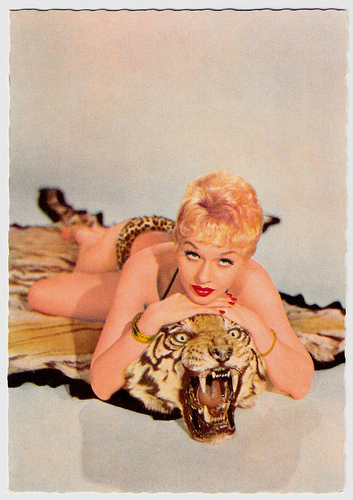
Vanda Hudson . German postcard by ISV, no. 11/6.
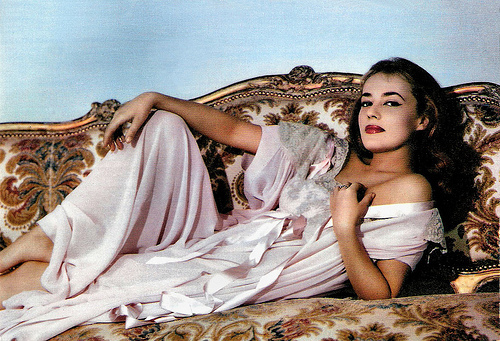
Jeanne Moreau . French postcard by Editions P.I., Paris, no. 1017. Photo: Sam Lévin.
Making Theatrical History
In 1968 Claire Gordon married writer and producer William Donaldson, who had auditioned her for Lady de Winter in his production of The Three Musketeers. In this production she made theatrical history as the first actress to appear naked on the British stage. The New Statesman wrote: "watch out for the bath scene; it's a breakthrough."
Her husband was quite a wild character. After his death in 2005, The Telegraph and The Times published hilarious obituaries. The Telegraph wrote Gordon "had introduced him to cannabis and that they held orgies, with call girls, naked DJs and two-way mirrors". In 1971 Donaldson fled wife and creditors and left for Ibiza, where he spent his last £2,000 on a glass-bottomed boat, hoping to make money out of tourists.
In 1992 Claire Gordon revealed the ‘Randy secrets of the real Mrs Root’ to a tabloid, describing how her husband sent pornographic pictures of her to contact magazines in exchange for a plug for her fitness video. ‘Mrs Root’ was a reference to Donaldson’s later satirical pseudonym Mr Henry Root, a Right-wing nutcase and wet fish merchant. Root specialised in writing brash, outrageous and frequently abusive letters to eminent public figures (including his ‘hero’ Margaret Thatcher), enclosing a one pound note. The letters appeared absurd to the public but not to those to whom they were addressed. The recipients duly replied, often unaware that the joke was on them. Compiled and published in 1980, The Henry Root Letters became the number one bestseller that year.
Meanwhile Claire Gordon had returned to the screen in the early 1970s in such British sexploitation as Cool It Carol! (Pete Walker, 1972), Suburban Wives (Derek Ford, 1972), and Sex Farm (Arnold L. Miller, 1973). Commuter Husbands (Derek Ford, 1974), the equally unfunny sequel to Suburban Wives, was her final film. Gordon joined the Open University and went on to graduate from Middlesex University with a BA degree in English and American History and Literature.
On TV she was later seen in the BBC Play of the Day The Amazing Miss Stella Estelle (John Davis, 1984). Later, she played the Fairy Godmother in Cinderella at the Princess Theatre, Hunstanton. She also worked with Sarah Louise Young in Clive Evans's two woman show The Nunnery.
In 2015, Claire Gordon died of a brain tumour in a nursing home in West London. By the end of her life, she had been working on her memoirs and a documentary about her experiences while living in Egypt before and after the 2011 revolution.
Scenes from Beat Girl (1960). Source: Michael Fox (You Tube).
American trailer for Konga (1961). Source: Mothra Blues (You Tube).
Source: Joe Cascio (DVD Drive-in), Bonnie Estridge (Daily Mail), The Telegraph, The Times, Wikipedia and .

German postcard by ISV, Sort 9/6.

German postcard by ISV, Sort VII/6. Photo: Anglo-Amalgamated.
Beat Girl
Claire Gordon or Clare Gordon was born in 1941. According To Wikipedia, her birthplace was the city of Cambridge, but according to IMDb, it was London. However, she is British. Her father was a doctor, and her mother a make-up artist, who worked for Max Factor.
Gordon made her West End theatre debut on a motor bike in The Darling Buds of May and then created the role of Peggy Evans in Neil Simon's Come Blow Your Horn. Her film debut was a cameo (bit part) as a Harem girl in the comedy I Only Arsked! (Montgomery Tully, 1958), about a group of of misfit soldiers who are desperately trying to fiddle themselves some leave. Instead they wrangle a posting to the British Middle-East protectorate of Darawa.
Two years later she had a bigger part in the British thriller And Women Shall Weep (John Lemont, 1960). That year she also played a typist in the British Noir Never Let Go (John Guillermin, 1960), starring Richard Todd and Peter Sellers, and played a supporting part in the Beatnik drama Beat Girl (Edmond T. Gréville, 1960) with David Farrar and Christopher Lee .
Into the 1960s, Gordon continued to play eye candy parts in such films as the Norman Wisdom comedy The Bulldog Breed (Robert Asher, 1960), Ticket to Paradise (1961) with that other British sexpot Vanda Hudson , and the King Kong rip-off Konga (John Lemont, 1961) starring Michael Gough. In his review at DVD Drive-in, Joe Cascio writes of her performance in Konga: “Claire Gordon as Sandra Banks is not much of an actress, but has other beautiful attributes in which one can easily understand why men young and old are turned on to her.”
On Television she guest-starred in the popular TV series The Danger Man (1960) starring Patrick McGoohan . Gordon was also a popular pin-up model for men’s magazines like Parade and Piccolo. In the Cliff Richard musical The Young Ones (Sidney J. Furie, 1961) she also appeared as a pin-up girl on the cover of a magazine browsed by Dench (Harold Scott).
In Italy she played a gangster’s moll in I due evasi di Sing Sing/Two Escape from Sing Sing (Lucio Fulci, 1964) starring the comedians Franco Franchi and Ciccio Ingrassia. Other 1960s films in which she appeared were the spy film Licensed to Kill (Lindsay Shonteff, 1965), and the George Bernard Shaw adaptation Great Catherine (Gordon Flemyng, 1968) starring Peter O’Toole and Jeanne Moreau .

Vanda Hudson . German postcard by ISV, no. 11/6.

Jeanne Moreau . French postcard by Editions P.I., Paris, no. 1017. Photo: Sam Lévin.
Making Theatrical History
In 1968 Claire Gordon married writer and producer William Donaldson, who had auditioned her for Lady de Winter in his production of The Three Musketeers. In this production she made theatrical history as the first actress to appear naked on the British stage. The New Statesman wrote: "watch out for the bath scene; it's a breakthrough."
Her husband was quite a wild character. After his death in 2005, The Telegraph and The Times published hilarious obituaries. The Telegraph wrote Gordon "had introduced him to cannabis and that they held orgies, with call girls, naked DJs and two-way mirrors". In 1971 Donaldson fled wife and creditors and left for Ibiza, where he spent his last £2,000 on a glass-bottomed boat, hoping to make money out of tourists.
In 1992 Claire Gordon revealed the ‘Randy secrets of the real Mrs Root’ to a tabloid, describing how her husband sent pornographic pictures of her to contact magazines in exchange for a plug for her fitness video. ‘Mrs Root’ was a reference to Donaldson’s later satirical pseudonym Mr Henry Root, a Right-wing nutcase and wet fish merchant. Root specialised in writing brash, outrageous and frequently abusive letters to eminent public figures (including his ‘hero’ Margaret Thatcher), enclosing a one pound note. The letters appeared absurd to the public but not to those to whom they were addressed. The recipients duly replied, often unaware that the joke was on them. Compiled and published in 1980, The Henry Root Letters became the number one bestseller that year.
Meanwhile Claire Gordon had returned to the screen in the early 1970s in such British sexploitation as Cool It Carol! (Pete Walker, 1972), Suburban Wives (Derek Ford, 1972), and Sex Farm (Arnold L. Miller, 1973). Commuter Husbands (Derek Ford, 1974), the equally unfunny sequel to Suburban Wives, was her final film. Gordon joined the Open University and went on to graduate from Middlesex University with a BA degree in English and American History and Literature.
On TV she was later seen in the BBC Play of the Day The Amazing Miss Stella Estelle (John Davis, 1984). Later, she played the Fairy Godmother in Cinderella at the Princess Theatre, Hunstanton. She also worked with Sarah Louise Young in Clive Evans's two woman show The Nunnery.
In 2015, Claire Gordon died of a brain tumour in a nursing home in West London. By the end of her life, she had been working on her memoirs and a documentary about her experiences while living in Egypt before and after the 2011 revolution.
Scenes from Beat Girl (1960). Source: Michael Fox (You Tube).
American trailer for Konga (1961). Source: Mothra Blues (You Tube).
Source: Joe Cascio (DVD Drive-in), Bonnie Estridge (Daily Mail), The Telegraph, The Times, Wikipedia and .
Published on April 08, 2016 22:00
April 7, 2016
EFSP's Dazzling Dozen: Girls Will Be Boys
We love tomboys. Girls who wear boys clothing and engage in soccer games and all kind of other physical activities that are considered in many cultures to be unfeminine or the domain of boys. There were many stars who liked yo do a bit of gender bender, think Marlene Dietrich, Greta Garbo, Katherine Hepburn. But earlier in the European cinema of the 1920s 'trouser' roles were even a trend. Today a salute to these revolutionary girls who weren't scared to act like boys.

British postcard in the Real Photo series. Photo: Hana.
English actress Vesta Tilley (1864–1952) was the most famous and well paid music hall male impersonator of her day, nicknamed ‘The London Idol’. She was a star in both Britain and the United States for over thirty years. Tilley also appeared in some very early silent films.

Else Bötticher (right) and Vilma Conti. German postcard by BNK, no. 33 583/2. Caption: "Fuss-Tanz-Duett. Fährt man erst per Untergrund.... Die Tanzhusaren." Collection: Didier Hanson.
In the early 20th century, German actress Else Bötticher (1880-1966) performed with famous stage stars in international theatres. During the 1910s, she made several silent films. In the sound era, she returned to the cinema but then only played small roles as wives and mothers.

Romanian postcard. Photo: Atelier Kossak, Timisoara. Collection: Didier Hanson.
It's difficult to find any information about this comic lady in drag, Anny Hochwald. Was she an Austrian or German cabaret performer of the early 20th Century, as her name and outfit suggest?

German postcard by Ross Verlag, Berlin, no. 644/3. Photo: Art-Films. Publicity still for Hamlet (Svend Gade, Heinz Schall, 1921), starring Asta Nielsen as Hamlet. Nielsen had produced the film herself. Collection: Didier Hanson.
Danish silent film actress Asta Nielsen (1881-1972), was one of the most popular leading ladies of the 1910s and one of the first international film stars. Of her 74 films between 1910 and 1932, seventy were made in Germany where she was known simply as Die Asta. Noted for her large dark eyes, mask-like face and boyish figure, Nielsen most often portrayed strong-willed passionate women trapped by tragic consequences.

German postcard by Verlag Hermann Leiser, Berlin-Wilm., no. 436. Photo: Zander & Labisch.
Austrian-born stage actress Mady Christians (1892-1951) was a star of the German silent cinema and appeared in Austrian, French, British and Hollywood films too.

German postcard by Ross Verlag, no. 1485/4, 1927-1928. Photo: Atelier Balázs, Berlin.
Lya Mara (1897-1960?) was one of the biggest stars of the German silent cinema. Her stardom was even the subject of a novel, which was published in 100 episodes between 1927 and 1928. Her career virtually ended after the arrival of sound film.

German postcard by Ross Verlag, no. 3228/3, 1928-1929. Photo: M. von Becovich (Atelier K. Schenker).
The profoundly sensitive acting of Austrian-British actress Elisabeth Bergner (1897-1986) influenced the German cinema of the 1920s and 1930s. She specialised in a bisexual type that she portrayed in Der Geiger von Florenz and in other film and stage roles. Nazism forced her to go in exile, but she worked successfully in the West End and on Broadway.
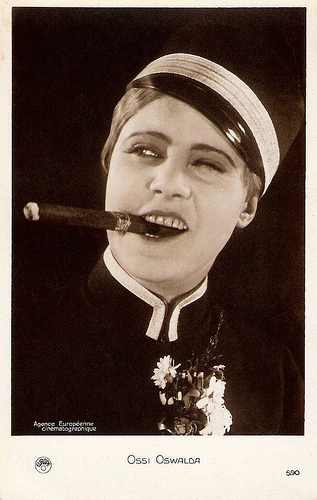
French postcard in the Europe series, no. 590. Photo: Agence Européenne Cinematographique.
Ossi Oswalda (1895-1947) was one of the most popular comediennes of the German silent cinema.

German postcard by Ross Verlag, no. 4037/1, 1929-1930. Photo: Atelier Badelkow, Berlin.
Lee Parry (1901-1977) was a German film actress of the silent and the early sound era, often in films by her husband Richard Eichberg. She appeared in 48 films between 1919 and 1939.

German postcard by Ross Verlag, no. 8157/1, 1933-1934. Photo: Walther Jaeger, Berlin.
Stage and screen actress Dolly Haas (1910-1994) was popular in the 1930s as a vivacious, red-haired gamine often wearing trousers in German and British films.
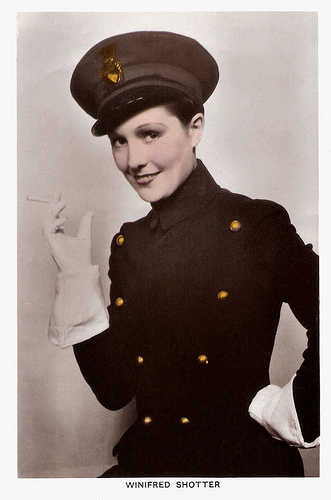
British postcard in the Colourgraph Series, London, no. C 146.
British film actress Winifred Shotter (1904–1996) was the pretty young thing in a number of the popular Aldwych farces, which were staged in London before and during the Second World War. During the 1930s, she also performed in early British films with great success.
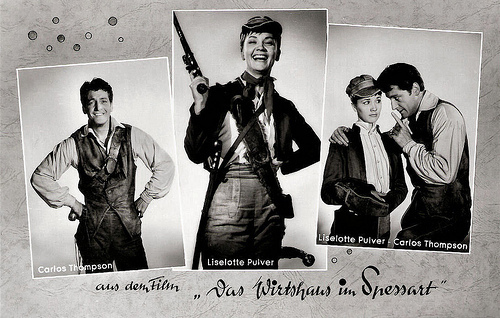
German postcard by Franz Josef Rüdel, Filmpostkartenverlag, Hamburg-Bergedorf, no. 2374. Photo: Witt / Constantin / Ringpress / Vogelmann. Publicity card for Das Wirtshaus im Spessart/The Spessart Inn (Kurt Hoffmann, 1958) with Liselotte Pulver and Carlos Thompson .
Swiss actress Liselotte Pulver (1929) was one of the most beloved stars of the German popular cinema of the 1950s and early 1960s. Despite a wide variety of roles, she is best remembered as the merry tomboy in sparkling comedies like Das Wirtshaus im Spessart/The Spessart Inn (1958).
Source: Laura Horak (Girls Will Be Boys) and Wikipedia.
This is a post for Postcard Friendship Friday, hosted by Beth at the The Best Hearts are Crunchy. You can visit her by clicking on the button below.


British postcard in the Real Photo series. Photo: Hana.
English actress Vesta Tilley (1864–1952) was the most famous and well paid music hall male impersonator of her day, nicknamed ‘The London Idol’. She was a star in both Britain and the United States for over thirty years. Tilley also appeared in some very early silent films.

Else Bötticher (right) and Vilma Conti. German postcard by BNK, no. 33 583/2. Caption: "Fuss-Tanz-Duett. Fährt man erst per Untergrund.... Die Tanzhusaren." Collection: Didier Hanson.
In the early 20th century, German actress Else Bötticher (1880-1966) performed with famous stage stars in international theatres. During the 1910s, she made several silent films. In the sound era, she returned to the cinema but then only played small roles as wives and mothers.

Romanian postcard. Photo: Atelier Kossak, Timisoara. Collection: Didier Hanson.
It's difficult to find any information about this comic lady in drag, Anny Hochwald. Was she an Austrian or German cabaret performer of the early 20th Century, as her name and outfit suggest?

German postcard by Ross Verlag, Berlin, no. 644/3. Photo: Art-Films. Publicity still for Hamlet (Svend Gade, Heinz Schall, 1921), starring Asta Nielsen as Hamlet. Nielsen had produced the film herself. Collection: Didier Hanson.
Danish silent film actress Asta Nielsen (1881-1972), was one of the most popular leading ladies of the 1910s and one of the first international film stars. Of her 74 films between 1910 and 1932, seventy were made in Germany where she was known simply as Die Asta. Noted for her large dark eyes, mask-like face and boyish figure, Nielsen most often portrayed strong-willed passionate women trapped by tragic consequences.

German postcard by Verlag Hermann Leiser, Berlin-Wilm., no. 436. Photo: Zander & Labisch.
Austrian-born stage actress Mady Christians (1892-1951) was a star of the German silent cinema and appeared in Austrian, French, British and Hollywood films too.

German postcard by Ross Verlag, no. 1485/4, 1927-1928. Photo: Atelier Balázs, Berlin.
Lya Mara (1897-1960?) was one of the biggest stars of the German silent cinema. Her stardom was even the subject of a novel, which was published in 100 episodes between 1927 and 1928. Her career virtually ended after the arrival of sound film.

German postcard by Ross Verlag, no. 3228/3, 1928-1929. Photo: M. von Becovich (Atelier K. Schenker).
The profoundly sensitive acting of Austrian-British actress Elisabeth Bergner (1897-1986) influenced the German cinema of the 1920s and 1930s. She specialised in a bisexual type that she portrayed in Der Geiger von Florenz and in other film and stage roles. Nazism forced her to go in exile, but she worked successfully in the West End and on Broadway.

French postcard in the Europe series, no. 590. Photo: Agence Européenne Cinematographique.
Ossi Oswalda (1895-1947) was one of the most popular comediennes of the German silent cinema.

German postcard by Ross Verlag, no. 4037/1, 1929-1930. Photo: Atelier Badelkow, Berlin.
Lee Parry (1901-1977) was a German film actress of the silent and the early sound era, often in films by her husband Richard Eichberg. She appeared in 48 films between 1919 and 1939.

German postcard by Ross Verlag, no. 8157/1, 1933-1934. Photo: Walther Jaeger, Berlin.
Stage and screen actress Dolly Haas (1910-1994) was popular in the 1930s as a vivacious, red-haired gamine often wearing trousers in German and British films.

British postcard in the Colourgraph Series, London, no. C 146.
British film actress Winifred Shotter (1904–1996) was the pretty young thing in a number of the popular Aldwych farces, which were staged in London before and during the Second World War. During the 1930s, she also performed in early British films with great success.

German postcard by Franz Josef Rüdel, Filmpostkartenverlag, Hamburg-Bergedorf, no. 2374. Photo: Witt / Constantin / Ringpress / Vogelmann. Publicity card for Das Wirtshaus im Spessart/The Spessart Inn (Kurt Hoffmann, 1958) with Liselotte Pulver and Carlos Thompson .
Swiss actress Liselotte Pulver (1929) was one of the most beloved stars of the German popular cinema of the 1950s and early 1960s. Despite a wide variety of roles, she is best remembered as the merry tomboy in sparkling comedies like Das Wirtshaus im Spessart/The Spessart Inn (1958).
Source: Laura Horak (Girls Will Be Boys) and Wikipedia.
This is a post for Postcard Friendship Friday, hosted by Beth at the The Best Hearts are Crunchy. You can visit her by clicking on the button below.

Published on April 07, 2016 22:00
April 6, 2016
Gérard Barray
French comedian and film and television actor Gérard Barray (1931) was one of the swashbuckling heroes of the French cinema. During the 1960s, he starred as D’Artagnan and Scaramouche, but also in many Eurospy films.

East-German postcard by Progress Film-Verleih, Berlin, no. 2915, 1967.
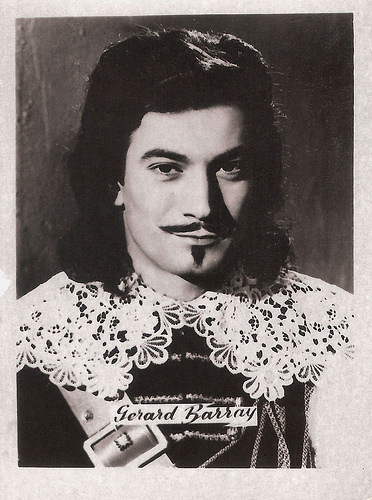
Small Romanian collector's card. Photo: publicity still for Les trois mousquetaires/The Three Musketeers (Bernard Borderie, 1961).
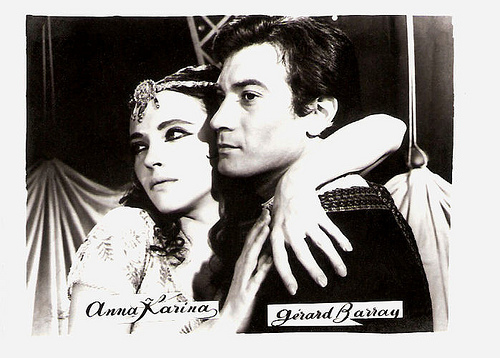
Small Romanian collector's card. Photo: publicity still for Sheherazade (Pierre-Gaspard-Huit, 1963) with Anna Karina .
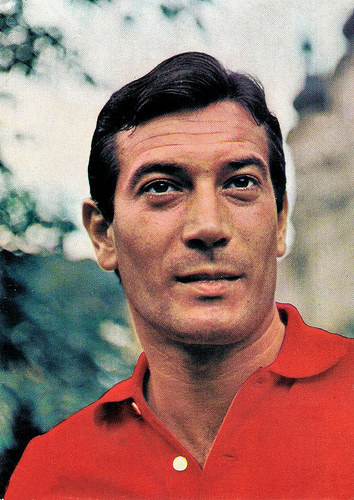
East-German postcard by Progress Film-Verleih, Berlin, no. 2260, 1965. Photo: Schwarz.
The Three Musketeers
Gérard Barray was born Gérard Marcel Louis Baraillé in Toulouse, France, in 1931. Barray's parents split up quickly and his mother, who came from Montauban decided to return to her hometown with her little boy.
Around the age of 15, he discovered a passion for jazz. Barray participated in a few shows in nightclubs while pursuing his studies and obtained a bachelor's degree at the Faculty of Toulouse. Camille Ricard, an actress and teacher at the Conservatory of Toulouse, advised him to go to Paris. She gave him a letter of recommendation for a friend, actor Noel Roquevert.
Barray enrolled at the Cours Simon, a drama school in Paris. Four years later, Gérard Barray won the Jury Prize. In 1955, he played his first small film roles as a gigolo in Chantage/Blackmail (Guy Lefranc, 1955) and as a gangster in the Film Noir Série noire/The Infiltrator (Pierre Foucaud, 1955) with Henri Vidal and Erich von Stroheim .
His first major film role was as the duke of Vallombreuse in the historical adventure film Le Capitaine Fracasse/Captain Fracasse (Pierre Gaspard-Huit, 1961), starring Jean Marais and based on a novel by Théophile Gautier. The film and Barray’s supporting role were a success and next he played the lead in another prestigious historical adventure, Les trois mousquetaires/The Three Musketeers (Bernard Borderie, 1961), a film adaption of the classic novel by Alexandre Dumas, père.
Reviewer jrjcat at IMDb: “This is a wonderful faithful version of Alexandre Dumas' The Three Musketeers. Gerard Barray is excellent as D'Artagnan and Mylene Demongeot is not only one of the most beautiful screen Milady de Winters rivalling that of Lana Turner but also excellent in the part as well.” Les trois mousquetaires became the sixth biggest French box office in 1961. A star was born.
During the 1960s Barray excelled in roles of knights with a big heart such as D'Artagnan, Scaramouche and Surcouf. These films include the Italian-French Alexandre Dumas adaptation I fratelli Corsi/The Corsican Brothers (Anton Giulio Majano, 1961) also starring Geoffrey Horne and Valérie Lagrange , Shéhérazade (Pierre Gaspard-Huit, 1963) starring Anna Karina , La máscara de Scaramouche/The Adventures of Scaramouche (Antonio Isasi-Isasmendi, 1963) and Le chevalier de Pardaillan/Clash of Steel (Bernard Borderie, 1962) plus its sequel Hardi Pardaillan!/The Gallant Musketeer (Bernard Borderie, 1964).
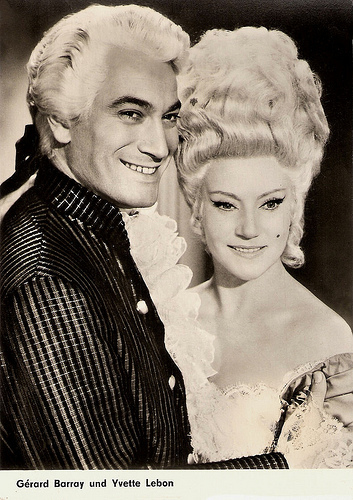
East-German postcard by Progress Film-Verleih, Berlin, no. 3034 1968. Photo: publicity still for La máscara de Scaramouche/The Adventures of Scaramouche (Antonio Isasi-Isasmendi, 1963) with Yvette Lebon .
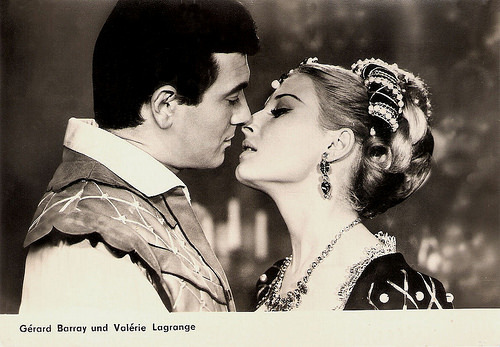
East-German postcard by Progress Film-Verleih, Berlin, no. 2961, 1967. Photo: publicity still for Hardi Pardaillan!/The Gallant Musketeer (Bernard Borderie, 1964) with Valérie Lagrange .
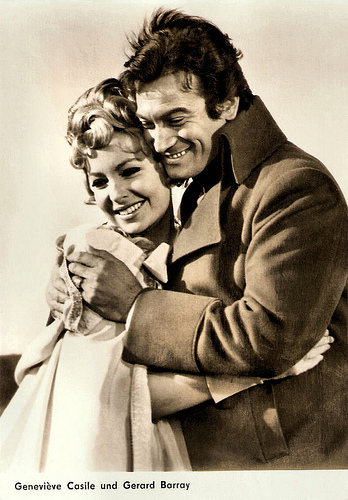
East-German postcard by Progress Film-Verleih, Berlin, no. 2828, 1967. Photo: publicity still for Surcouf, l'eroe dei sette mari/The Sea Pirate (Sergio Bergonzelli, Roy Rowland, 1966) with Geneviève Casile.
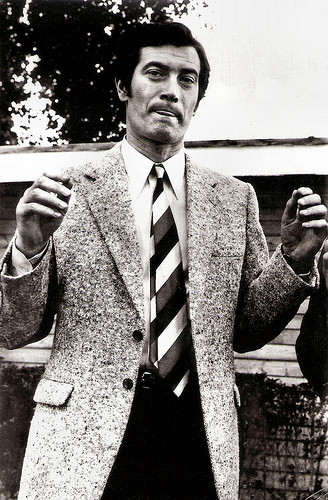
Romanian postcard by Casa Filmului Acin, no. 454. Photo: publicity stil for Béru et ces dames/Beru and These Women (Guy Lefranc, 1968).
Next Time I'll Kill You
During the 1960s, Gérard Barray starred in a dozen feature films, most of which were box-office successes and widely known abroad. Besides Swashbucklers, he became one of the Eurospy stars with his roles in thrillers like Gibraltar (Pierre Gaspard-Huit, 1964) with Hildegard Knef and Baraka sur X 13/Agent X-77 Orders to Kill (Maurice Cloche, 1966) opposite Sylva Koscina .
He also starred as police commissioner San Antonio films in the thrillers Sale temps pour les mouches/Next Time I'll Kill You (Guy Lefranc, 1966) and Béru et ces dames/Beru and These Women (Guy Lefranc, 1966), both with Jean Richard. He continued to play in popular Swashbucklers such as the French-Italian-Spanish adventure film Surcouf, le tigre des sept mers/The Sea Pirate (Sergio Bergonzelli, Roy Rowland, 1966) with Antonella Lualdi .
In 1969, he played a mysterious museum curator who seduces a young English teacher ( Claude Jade ) in Le Témoin/The Witness (Anne Walter, 1969). It was his last major role. Daniel Denner at IMDb: “he changed his profile to the dark side as Van Britten - his most interesting part, but without great success.” For Claude Berri he appeared in the supporting role of Richard, a rather temperamental star actor in Le cinéma de papa (1970), but mostly he worked for TV.
Decades later he made a comeback in the cinema opposite Eduardo Noriega and Penélope Cruz in Abre los ojos/Open Your Eyes (Alejandro Amenabar. 1997), the original version of Vanilla Sky (Cameron Crowe, 2001) with Tom Cruise. Barray appeared in more Spanish films and TV series and also played a small part in the thriller Sexy Beast (Jonathan Glazer, 2000).
In 2010, Gérard Barray was appointed an Officer in the Order of Arts and Letters. Since 1965, he is married to Theresa Lorca and they have two children. Gérard Barray lives in Andalusia in the south of Spain and is occupied as a grandfather of three.
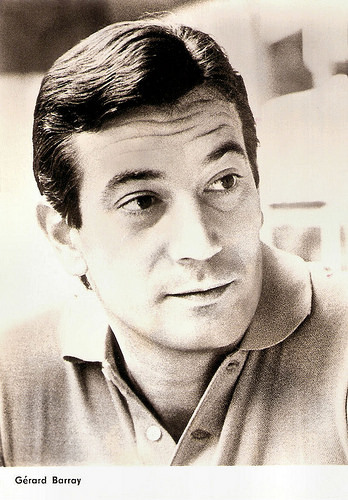
East-German postcard by Progress Film-Verleih, Berlin, no. 3033, 1968. Photo: Schwarz.
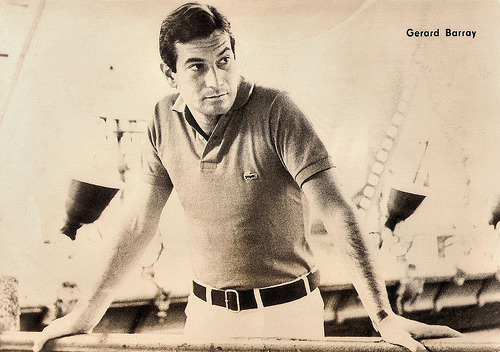
East-German postcard by Progress Film-Verleih, Berlin, no. 21, 1970. Photo: Schwarz.
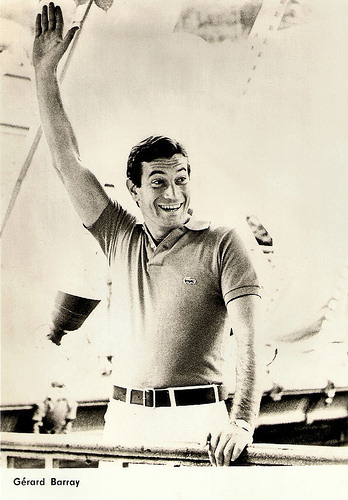
East-German postcard by Progress Film-Verleih, Berlin, no. 3018, 1967. Photo: Schwarz.
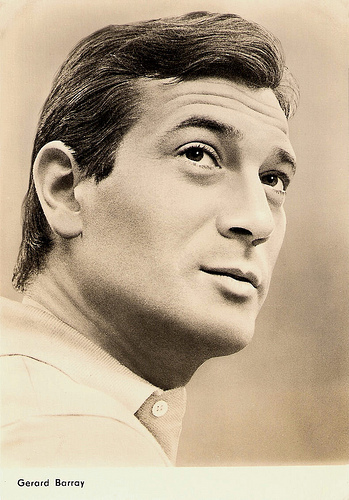
East-German postcard by Progress Film-Verleih, Berlin, no. 2216, 1965. Photo: Schwarz.
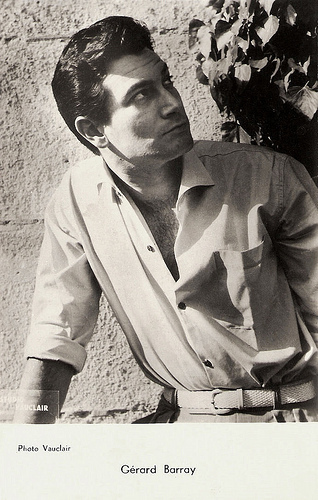
French postcard by Editions P.I., Paris, no. 1138. Photo: Vauclair.
Sources: Donatienne (L’encinematheque – French), (IMDb), Wikipedia and .

East-German postcard by Progress Film-Verleih, Berlin, no. 2915, 1967.

Small Romanian collector's card. Photo: publicity still for Les trois mousquetaires/The Three Musketeers (Bernard Borderie, 1961).

Small Romanian collector's card. Photo: publicity still for Sheherazade (Pierre-Gaspard-Huit, 1963) with Anna Karina .

East-German postcard by Progress Film-Verleih, Berlin, no. 2260, 1965. Photo: Schwarz.
The Three Musketeers
Gérard Barray was born Gérard Marcel Louis Baraillé in Toulouse, France, in 1931. Barray's parents split up quickly and his mother, who came from Montauban decided to return to her hometown with her little boy.
Around the age of 15, he discovered a passion for jazz. Barray participated in a few shows in nightclubs while pursuing his studies and obtained a bachelor's degree at the Faculty of Toulouse. Camille Ricard, an actress and teacher at the Conservatory of Toulouse, advised him to go to Paris. She gave him a letter of recommendation for a friend, actor Noel Roquevert.
Barray enrolled at the Cours Simon, a drama school in Paris. Four years later, Gérard Barray won the Jury Prize. In 1955, he played his first small film roles as a gigolo in Chantage/Blackmail (Guy Lefranc, 1955) and as a gangster in the Film Noir Série noire/The Infiltrator (Pierre Foucaud, 1955) with Henri Vidal and Erich von Stroheim .
His first major film role was as the duke of Vallombreuse in the historical adventure film Le Capitaine Fracasse/Captain Fracasse (Pierre Gaspard-Huit, 1961), starring Jean Marais and based on a novel by Théophile Gautier. The film and Barray’s supporting role were a success and next he played the lead in another prestigious historical adventure, Les trois mousquetaires/The Three Musketeers (Bernard Borderie, 1961), a film adaption of the classic novel by Alexandre Dumas, père.
Reviewer jrjcat at IMDb: “This is a wonderful faithful version of Alexandre Dumas' The Three Musketeers. Gerard Barray is excellent as D'Artagnan and Mylene Demongeot is not only one of the most beautiful screen Milady de Winters rivalling that of Lana Turner but also excellent in the part as well.” Les trois mousquetaires became the sixth biggest French box office in 1961. A star was born.
During the 1960s Barray excelled in roles of knights with a big heart such as D'Artagnan, Scaramouche and Surcouf. These films include the Italian-French Alexandre Dumas adaptation I fratelli Corsi/The Corsican Brothers (Anton Giulio Majano, 1961) also starring Geoffrey Horne and Valérie Lagrange , Shéhérazade (Pierre Gaspard-Huit, 1963) starring Anna Karina , La máscara de Scaramouche/The Adventures of Scaramouche (Antonio Isasi-Isasmendi, 1963) and Le chevalier de Pardaillan/Clash of Steel (Bernard Borderie, 1962) plus its sequel Hardi Pardaillan!/The Gallant Musketeer (Bernard Borderie, 1964).

East-German postcard by Progress Film-Verleih, Berlin, no. 3034 1968. Photo: publicity still for La máscara de Scaramouche/The Adventures of Scaramouche (Antonio Isasi-Isasmendi, 1963) with Yvette Lebon .

East-German postcard by Progress Film-Verleih, Berlin, no. 2961, 1967. Photo: publicity still for Hardi Pardaillan!/The Gallant Musketeer (Bernard Borderie, 1964) with Valérie Lagrange .

East-German postcard by Progress Film-Verleih, Berlin, no. 2828, 1967. Photo: publicity still for Surcouf, l'eroe dei sette mari/The Sea Pirate (Sergio Bergonzelli, Roy Rowland, 1966) with Geneviève Casile.

Romanian postcard by Casa Filmului Acin, no. 454. Photo: publicity stil for Béru et ces dames/Beru and These Women (Guy Lefranc, 1968).
Next Time I'll Kill You
During the 1960s, Gérard Barray starred in a dozen feature films, most of which were box-office successes and widely known abroad. Besides Swashbucklers, he became one of the Eurospy stars with his roles in thrillers like Gibraltar (Pierre Gaspard-Huit, 1964) with Hildegard Knef and Baraka sur X 13/Agent X-77 Orders to Kill (Maurice Cloche, 1966) opposite Sylva Koscina .
He also starred as police commissioner San Antonio films in the thrillers Sale temps pour les mouches/Next Time I'll Kill You (Guy Lefranc, 1966) and Béru et ces dames/Beru and These Women (Guy Lefranc, 1966), both with Jean Richard. He continued to play in popular Swashbucklers such as the French-Italian-Spanish adventure film Surcouf, le tigre des sept mers/The Sea Pirate (Sergio Bergonzelli, Roy Rowland, 1966) with Antonella Lualdi .
In 1969, he played a mysterious museum curator who seduces a young English teacher ( Claude Jade ) in Le Témoin/The Witness (Anne Walter, 1969). It was his last major role. Daniel Denner at IMDb: “he changed his profile to the dark side as Van Britten - his most interesting part, but without great success.” For Claude Berri he appeared in the supporting role of Richard, a rather temperamental star actor in Le cinéma de papa (1970), but mostly he worked for TV.
Decades later he made a comeback in the cinema opposite Eduardo Noriega and Penélope Cruz in Abre los ojos/Open Your Eyes (Alejandro Amenabar. 1997), the original version of Vanilla Sky (Cameron Crowe, 2001) with Tom Cruise. Barray appeared in more Spanish films and TV series and also played a small part in the thriller Sexy Beast (Jonathan Glazer, 2000).
In 2010, Gérard Barray was appointed an Officer in the Order of Arts and Letters. Since 1965, he is married to Theresa Lorca and they have two children. Gérard Barray lives in Andalusia in the south of Spain and is occupied as a grandfather of three.

East-German postcard by Progress Film-Verleih, Berlin, no. 3033, 1968. Photo: Schwarz.

East-German postcard by Progress Film-Verleih, Berlin, no. 21, 1970. Photo: Schwarz.

East-German postcard by Progress Film-Verleih, Berlin, no. 3018, 1967. Photo: Schwarz.

East-German postcard by Progress Film-Verleih, Berlin, no. 2216, 1965. Photo: Schwarz.

French postcard by Editions P.I., Paris, no. 1138. Photo: Vauclair.
Sources: Donatienne (L’encinematheque – French), (IMDb), Wikipedia and .
Published on April 06, 2016 22:00
April 5, 2016
Imported from the USA: Dolores del Río
Mexican and American actress Dolores del Río (1905–1983) was a Hollywood star in the 1920s and 1930s, and one of the most important female actresses of the Golden Age of Mexican cinema in the 1940s and 1950s. Del Río was the first major Latin cross-over star in Hollywood, and was considered one of the most beautiful faces that have emerged in the Hollywood cinema. She also appeared in several European films.
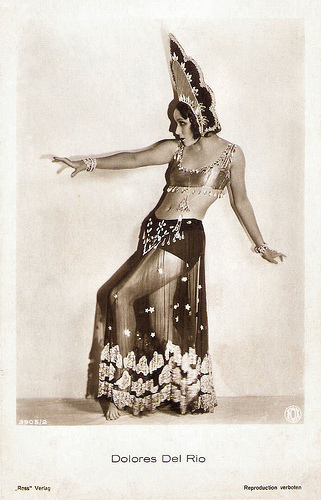
German postcard by Ross Verlag, no. 3905/2, 1928-1929. Photo: Fox. Publicity still for The Red Dance (Raoul Walsh, 1928). Del Rio is wearing a kokoshnik (Russian: коко́шник), a traditional Russian head-dress worn by women and girls.

German postcard by Ross Verlag, no. 3905/3, 1928-1929. Photo: Fox. Publicity still for The Red Dance (Raoul Walsh, 1928).

German postcard by Ross Verlag, no. 4993/1, 1929-1930. Photo: Fox.

German postcard by Ross Verlag, no. 5005/1, 1930-1931. Photo: Fox. Publicity still for The Trail of '98 (Clarence Brown, 1928).

German postcard by Ross Verlag, no. 5005/2, 1930-1931. Photo: Fox. Publicity still for The Trail of '98 (Clarence Brown, 1928).
The Female Valentino
Dolores del Río was born Maria de los Dolores Asunsolo Lopez-Negrete in 1905 in Durango, Mexico. She was the daughter of Jesus Leonardo Asunsolo Jacques, who worked as a bank director, and Antonia Lopez-Negrete. They were members of the high class until the Mexican Revolution when they lost all their assets.
It was around this time that Dolores began dreaming of becoming an actress. On her mother's side, Dolores was a cousin of the Mexican filmmaker Julio Bracho and the Mexican actors Ramón Novarro and Andrea Palma. Besides acting, she also enjoyed dancing, especially ballet. While studying dancing, she would earn money by dancing for the rich families of the Mexican aristocracy.
A few years later, Dolores moved to Mexico City where she was discovered by director Edwin Carewe. He was so entranced by her that he became her agent, manager, producer and director. In 1925, she made her debut in the film Joanna (Edwin Carewe, 1925), starring Dorothy Mackaill. Because of her exotic looks, she was cast in a vamp role. Unfortunately, her part in the film was only about 5 minutes long and she was billed as Dorothy Del Rio in the credits. Carewe reassured her that the little that she appeared in the film looked extremely good and the public became interested in her.
Her second film was High Steppers (Edwin Carewe, 1926), starring Mary Astor and Del Río taking the second female credit. Carewe began promoting her as 'the female Valentino'. In the comedy Pals First (Edwin Carewe, 1926), he gave Del Río her first starring role. The films were not blockbusters, but helped to increase Del Río's popularity. Then, she was named a WAMPAS Baby Star along with Joan Crawford, Mary Astor, Fay Wray and Janet Gaynor, and Del Rio appeared in the hit film What Price Glory? (Raoul Walsh, 1926).
In 1927, Dolores was cast in the film The Loves of Carmen (Raoul Walsh, 1927). The first version, made 10 years earlier, had starred Theda Bara in the title role, but director Raoul Walsh decided to try it with a leading lady who was actually of Latin descent. Her background in dance certainly added to her convincing portrayal. Another box office hit was Resurrection (Edwin Carewe, 1927).
The following year, she had another career boost. United Artists signed Dolores up and she appeared in the film Ramona (Edwin Carewe, 1928), and also recorded the theme song. The film did have a synchronized score, but it was not considered a talkie. The theme song was heard on the radio with great strength both in the United States and Europe, and helped to increase the enormous success of the film. Del Rio made an extensive promotional tour in Euopa.
In March of 1928, the studio asked her over to Mary Pickford's home along with other big names so that they could speak on a radio show and give the audiences a taste of what they sounded like. Dolores ended up singing, which was a great treat for everyone. United Artists was getting a little fed up with the partnership between Dolores and Edwin Carewe. They felt that he used her as a stepping stone and they wanted to be in charge of her career. UA finally convinced Dolores to cut ties with the famed director which took a great weight off her shoulders. Carewe demanded that she pay him a huge amount of money to compensate for his losses and he cast one of Dolores's main rivals, Lupe Velez in his newest picture.

German postcard by Ross Verlag, no. 1917/3, 1927-1928. Photo: United Artists. Publicity still for Resurrection (Edwin Carewe, 1927) with Rod La Rocque.

German postcard by Ross Verlag, no. 3378/2, 1928-1929. Photo: United Artists. Publicity still for Ramona (Edwin Carewe, 1928).

German postcard by Ross Verlag, no. 4266/1, 1929-1930. Photo: Metro-Goldwyn-Mayer. Publicity still for The Trail of '98 (Clarence Brown, 1928) with Ralph Forbes .
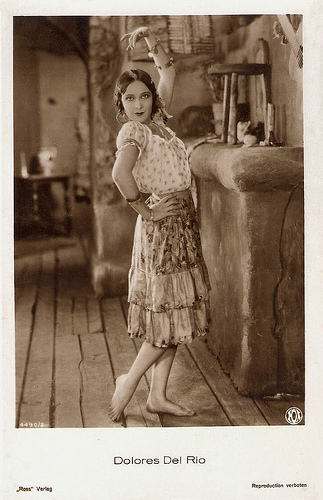
German postcard by Ross Verlag, no. 4490/2, 1929-1930. Photo: Fox. Publicity still for The Loves of Carmen (Raoul Walsh, 1927).

German postcard by Ross Verlag, no. 4786/2, 1929-1930. Photo: United Artists.
Great Hollywood Princess
Dolores del Río continued focusing on her own career. In 1930, she appeared in the film The Bad One, with Edmund Lowe and Boris Karloff. Successful was also Bird of Paradise (King Vidor, 1932). She made the transition from 'an exotic star across the border' to one of the great Hollywood princesses. She appeared in Flying Down to Rio (Thornton Freeland, 1933) alongside Fred Astaire and Ginger Rogers in their first pairing.
Then she starred in Madame DuBarry (William Dieterle, 1934), but the film had the misfortune or being torn apart by the Hays office. It was edited so much that it came out almost nothing like the original story. The audiences didn't like it, and neither did the people involved in the making of the film.
As the 1930s progressed, her box office appeal began to wain. The heads of the studios preferred leading ladies like Joan Crawford and Norma Shearer, not Latina actresses. After making Journey into Fear (Norman Foster, 1942) with Orson Welles as producer, she moved back to Mexico
In Mexico, the film industry was at that time at its peak. There she received another career boost and made some of her most important films. These films like Flor silvestre/Wild Flower (Emilio 'El Indio' Fernández, 1943), María Candelaria (Emilio Fernández, 1943) with Pedro Armendariz, Las Abandonadas/The Abandoned (Emilio Fernández, 1944), Bugambilia/Secret Love (Emilio Fernández, 1944), La Otra/The Other One (Roberto Gavaldón, 1946) and La Malquerida/The unloved (Emilio Fernández, 1949), are now considered classic masterpieces and they helped boost Mexican cinema worldwide. María Candelaria (Emilio Fernández, 1943) was the first Mexican film to be screened at the Cannes International Film Festival where it won the Grand Prix becoming the first Latin American film to do so. The film was a great success in Europe and allowed Del Río to keep her international prestige.
In 1934, Del Río, along with other Mexican film stars of Hollywood like Ramón Novarro and Lupe Vélez, was accused of promoting Communism in California. This happened after the stars attended a special screening of the Sergei Eisenstein's film ¡Que viva México! (Grigori Aleksandrov, Sergei M. Eisenstein, 1932). Twenty years later, this would have consequences for her career. In 1954, Del Río was slated to appear in the 20th Century Fox film Broken Lance (Edward Dmytryk, 1954). The US government denied her permission to work in the United States, accusing her of being sympathetic to international communism. So she stayed in Mexico making films and with the decline of the Mexican cinema she opted for work in theatre.
In 1960 she returned to Hollywood and played opposite Elvis Presley in Flaming Star (Don Siegel, 1960). Elvis greeted her with flowers and said he knew exactly who she was and said it was an honour to work with her. Dolores soon began to look at him as a son and was very affectionate with him. She also appeared in Cheyenne Autumn (John Ford, 1964) and in European films like La dama del alba/The Lady of the Dawn (Francisco Rovira Beleta, 1966) and C'era una volta/Cinderella: Italian Style (Francesco Rosi, 1967) with Sophia Loren . Her final film role was as a grandmother opposite Anthony Quinn in The Children of Sanchez (Hal Bartlett, 1978).
Dolores del Río passed away in 1973 from liver disease in Newport Beach, California. Dolores Del Rio was married three times. Her first husband was Jaime Martinez del Río, the son of a wealthy Mexican family. She was only 16 years old when they met and was 18 years younger than him. Her second marriage was to MGM art director and production designer Cedric Gibbons from 1930 until 1940. Their divorce was caused by her affair with Orson Welles . The affair with Welles lasted two years and was very intense. He later called her the great love of his life. Her third and final marriage was to Lewis Riley, an American businessman. They married in 1959 and remained married until her death in 1983.

German postcard by Ross Verlag, no. 3660/3, 1928-1929 Photo: United Artists.

Austrian postcard by Iris Verlag, no. 5148. Photo: Fox Film. Publicity still for The Trail of '98 (Clarence Brown, 1928).

Austrian postcard by Iris Verlag, no. 5185.

Austrian postcard by Iris-Verlag, no. 5953. Photo: United Artists / Dr. Hauser u. Co. Publicity still for Revenge (Edwin Carewe, 1928) with James Marcus.

German postcard by Ross Verlag, no. 4786/2, 1929-1930. Photo: United Artists.
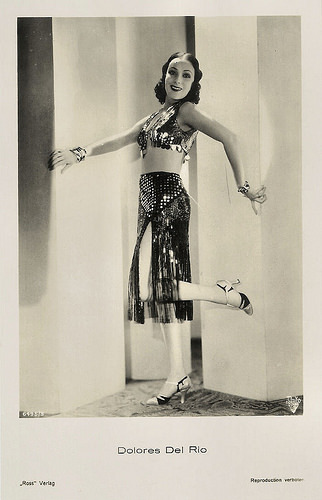
German postcard by Ross Verlag, no. 6495/3, 1931-1932. Photo: Radio Pictures.

German postcard by Ross Verlag, no. 6613/1, 1931-1932. Photo: RKO.

German cigarette card in the series Unsere Bunten Filmbilder by Ross Verlag for Cigarettenfabrik Josetti, Berlin, no. 232. Photo: Radio Pict. Corp.
Source: Jessica Keaton (Silence is Platinum), Wikipedia and
For now, this was the last post in our series Imported from the USA. Next week starts a new series of film specials.

German postcard by Ross Verlag, no. 3905/2, 1928-1929. Photo: Fox. Publicity still for The Red Dance (Raoul Walsh, 1928). Del Rio is wearing a kokoshnik (Russian: коко́шник), a traditional Russian head-dress worn by women and girls.

German postcard by Ross Verlag, no. 3905/3, 1928-1929. Photo: Fox. Publicity still for The Red Dance (Raoul Walsh, 1928).

German postcard by Ross Verlag, no. 4993/1, 1929-1930. Photo: Fox.

German postcard by Ross Verlag, no. 5005/1, 1930-1931. Photo: Fox. Publicity still for The Trail of '98 (Clarence Brown, 1928).

German postcard by Ross Verlag, no. 5005/2, 1930-1931. Photo: Fox. Publicity still for The Trail of '98 (Clarence Brown, 1928).
The Female Valentino
Dolores del Río was born Maria de los Dolores Asunsolo Lopez-Negrete in 1905 in Durango, Mexico. She was the daughter of Jesus Leonardo Asunsolo Jacques, who worked as a bank director, and Antonia Lopez-Negrete. They were members of the high class until the Mexican Revolution when they lost all their assets.
It was around this time that Dolores began dreaming of becoming an actress. On her mother's side, Dolores was a cousin of the Mexican filmmaker Julio Bracho and the Mexican actors Ramón Novarro and Andrea Palma. Besides acting, she also enjoyed dancing, especially ballet. While studying dancing, she would earn money by dancing for the rich families of the Mexican aristocracy.
A few years later, Dolores moved to Mexico City where she was discovered by director Edwin Carewe. He was so entranced by her that he became her agent, manager, producer and director. In 1925, she made her debut in the film Joanna (Edwin Carewe, 1925), starring Dorothy Mackaill. Because of her exotic looks, she was cast in a vamp role. Unfortunately, her part in the film was only about 5 minutes long and she was billed as Dorothy Del Rio in the credits. Carewe reassured her that the little that she appeared in the film looked extremely good and the public became interested in her.
Her second film was High Steppers (Edwin Carewe, 1926), starring Mary Astor and Del Río taking the second female credit. Carewe began promoting her as 'the female Valentino'. In the comedy Pals First (Edwin Carewe, 1926), he gave Del Río her first starring role. The films were not blockbusters, but helped to increase Del Río's popularity. Then, she was named a WAMPAS Baby Star along with Joan Crawford, Mary Astor, Fay Wray and Janet Gaynor, and Del Rio appeared in the hit film What Price Glory? (Raoul Walsh, 1926).
In 1927, Dolores was cast in the film The Loves of Carmen (Raoul Walsh, 1927). The first version, made 10 years earlier, had starred Theda Bara in the title role, but director Raoul Walsh decided to try it with a leading lady who was actually of Latin descent. Her background in dance certainly added to her convincing portrayal. Another box office hit was Resurrection (Edwin Carewe, 1927).
The following year, she had another career boost. United Artists signed Dolores up and she appeared in the film Ramona (Edwin Carewe, 1928), and also recorded the theme song. The film did have a synchronized score, but it was not considered a talkie. The theme song was heard on the radio with great strength both in the United States and Europe, and helped to increase the enormous success of the film. Del Rio made an extensive promotional tour in Euopa.
In March of 1928, the studio asked her over to Mary Pickford's home along with other big names so that they could speak on a radio show and give the audiences a taste of what they sounded like. Dolores ended up singing, which was a great treat for everyone. United Artists was getting a little fed up with the partnership between Dolores and Edwin Carewe. They felt that he used her as a stepping stone and they wanted to be in charge of her career. UA finally convinced Dolores to cut ties with the famed director which took a great weight off her shoulders. Carewe demanded that she pay him a huge amount of money to compensate for his losses and he cast one of Dolores's main rivals, Lupe Velez in his newest picture.

German postcard by Ross Verlag, no. 1917/3, 1927-1928. Photo: United Artists. Publicity still for Resurrection (Edwin Carewe, 1927) with Rod La Rocque.

German postcard by Ross Verlag, no. 3378/2, 1928-1929. Photo: United Artists. Publicity still for Ramona (Edwin Carewe, 1928).

German postcard by Ross Verlag, no. 4266/1, 1929-1930. Photo: Metro-Goldwyn-Mayer. Publicity still for The Trail of '98 (Clarence Brown, 1928) with Ralph Forbes .

German postcard by Ross Verlag, no. 4490/2, 1929-1930. Photo: Fox. Publicity still for The Loves of Carmen (Raoul Walsh, 1927).

German postcard by Ross Verlag, no. 4786/2, 1929-1930. Photo: United Artists.
Great Hollywood Princess
Dolores del Río continued focusing on her own career. In 1930, she appeared in the film The Bad One, with Edmund Lowe and Boris Karloff. Successful was also Bird of Paradise (King Vidor, 1932). She made the transition from 'an exotic star across the border' to one of the great Hollywood princesses. She appeared in Flying Down to Rio (Thornton Freeland, 1933) alongside Fred Astaire and Ginger Rogers in their first pairing.
Then she starred in Madame DuBarry (William Dieterle, 1934), but the film had the misfortune or being torn apart by the Hays office. It was edited so much that it came out almost nothing like the original story. The audiences didn't like it, and neither did the people involved in the making of the film.
As the 1930s progressed, her box office appeal began to wain. The heads of the studios preferred leading ladies like Joan Crawford and Norma Shearer, not Latina actresses. After making Journey into Fear (Norman Foster, 1942) with Orson Welles as producer, she moved back to Mexico
In Mexico, the film industry was at that time at its peak. There she received another career boost and made some of her most important films. These films like Flor silvestre/Wild Flower (Emilio 'El Indio' Fernández, 1943), María Candelaria (Emilio Fernández, 1943) with Pedro Armendariz, Las Abandonadas/The Abandoned (Emilio Fernández, 1944), Bugambilia/Secret Love (Emilio Fernández, 1944), La Otra/The Other One (Roberto Gavaldón, 1946) and La Malquerida/The unloved (Emilio Fernández, 1949), are now considered classic masterpieces and they helped boost Mexican cinema worldwide. María Candelaria (Emilio Fernández, 1943) was the first Mexican film to be screened at the Cannes International Film Festival where it won the Grand Prix becoming the first Latin American film to do so. The film was a great success in Europe and allowed Del Río to keep her international prestige.
In 1934, Del Río, along with other Mexican film stars of Hollywood like Ramón Novarro and Lupe Vélez, was accused of promoting Communism in California. This happened after the stars attended a special screening of the Sergei Eisenstein's film ¡Que viva México! (Grigori Aleksandrov, Sergei M. Eisenstein, 1932). Twenty years later, this would have consequences for her career. In 1954, Del Río was slated to appear in the 20th Century Fox film Broken Lance (Edward Dmytryk, 1954). The US government denied her permission to work in the United States, accusing her of being sympathetic to international communism. So she stayed in Mexico making films and with the decline of the Mexican cinema she opted for work in theatre.
In 1960 she returned to Hollywood and played opposite Elvis Presley in Flaming Star (Don Siegel, 1960). Elvis greeted her with flowers and said he knew exactly who she was and said it was an honour to work with her. Dolores soon began to look at him as a son and was very affectionate with him. She also appeared in Cheyenne Autumn (John Ford, 1964) and in European films like La dama del alba/The Lady of the Dawn (Francisco Rovira Beleta, 1966) and C'era una volta/Cinderella: Italian Style (Francesco Rosi, 1967) with Sophia Loren . Her final film role was as a grandmother opposite Anthony Quinn in The Children of Sanchez (Hal Bartlett, 1978).
Dolores del Río passed away in 1973 from liver disease in Newport Beach, California. Dolores Del Rio was married three times. Her first husband was Jaime Martinez del Río, the son of a wealthy Mexican family. She was only 16 years old when they met and was 18 years younger than him. Her second marriage was to MGM art director and production designer Cedric Gibbons from 1930 until 1940. Their divorce was caused by her affair with Orson Welles . The affair with Welles lasted two years and was very intense. He later called her the great love of his life. Her third and final marriage was to Lewis Riley, an American businessman. They married in 1959 and remained married until her death in 1983.

German postcard by Ross Verlag, no. 3660/3, 1928-1929 Photo: United Artists.

Austrian postcard by Iris Verlag, no. 5148. Photo: Fox Film. Publicity still for The Trail of '98 (Clarence Brown, 1928).

Austrian postcard by Iris Verlag, no. 5185.

Austrian postcard by Iris-Verlag, no. 5953. Photo: United Artists / Dr. Hauser u. Co. Publicity still for Revenge (Edwin Carewe, 1928) with James Marcus.

German postcard by Ross Verlag, no. 4786/2, 1929-1930. Photo: United Artists.

German postcard by Ross Verlag, no. 6495/3, 1931-1932. Photo: Radio Pictures.

German postcard by Ross Verlag, no. 6613/1, 1931-1932. Photo: RKO.

German cigarette card in the series Unsere Bunten Filmbilder by Ross Verlag for Cigarettenfabrik Josetti, Berlin, no. 232. Photo: Radio Pict. Corp.
Source: Jessica Keaton (Silence is Platinum), Wikipedia and
For now, this was the last post in our series Imported from the USA. Next week starts a new series of film specials.
Published on April 05, 2016 22:00
Paul van Yperen's Blog
- Paul van Yperen's profile
- 13 followers
Paul van Yperen isn't a Goodreads Author
(yet),
but they
do have a blog,
so here are some recent posts imported from
their feed.



